
Rights Reserved - Free Access.
This digital object is protected by copyright and/or related rights. This digital object is accessible without charge, but its use is subject to written permission.
Unless expressly stated otherwise in the licensing conditions, you are free to make any of the acts permitted by your national copyright and related rights act, including browsing, printing and making a copy for your own personal purposes.
All other acts of reproduction and communication to the public are subject to the licensing conditions attached to the digital object.
ARMY BOOTS OF THE WORLD. REVIEWS
Important notice: we do not sell any boots! The prices are given for information purposes only!
Japan![]()

Combat boots and uniform of Japan Ground Self Defense Force (JGSDF)
When Japan entered WWII on 7 December 1941, the Imperial Japanese Army (IJA) consisted of 51 divisions and 1.7 million men. By the end of the war in 1945, the IJA had grown to 5.5 million soldiers in 145 divisions.
Japan surrendered to the Allied Powers on August 15, 1945, and officially exchanged instruments of surrender in Tokyo Bay on September 2, after which Japan underwent a U.S.-led military occupation for seven years, until April 28, 1952. Article 9 of the Japanese Constitution of 1947 explicitly disavows war as an instrument of state policy and promises that Japan will never maintain a military.
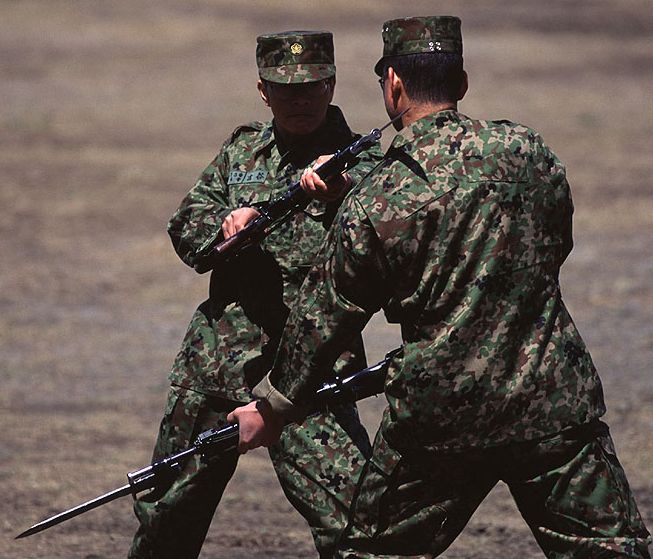
Japan’s final defeat brought about the disbandment of its armed forces to prevent any repeat of its militaristic ambitions. However, the USA was soon encouraging Japan to re-establish a military, with the catalyst being the outbreak of the Korean War on 25 June 1950. After the Korean War descended into an unsteady armistice on 27 July 1953, fears remained that the USSR would continue flexing its military muscles in the region and invade Japan.
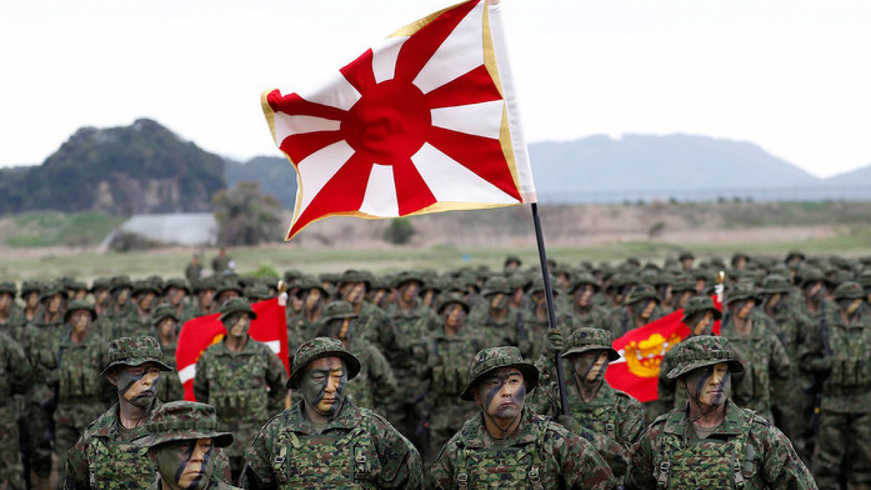
In 1954 the Police Reserve Force evolved into the Japan Self-Defense Forces (JSDF) (Japanese: 自衛隊 (Jieitai)), consisting of its three Ground, Air and Maritime components. They are controlled by the Ministry of Defense with the Prime Minister as commander-in-chief. Article 9 of the 1947 Constitution of Japan states, "Japanese people renounce war as a sovereign right of the nation", and "land, sea, and air forces, as well as other war potential, will never be maintained". The nomenclature "Self-Defense Force" was thus a deliberate attempt to sidestep the fact that Japan had once again formed a viable Army, Navy and Air Force.
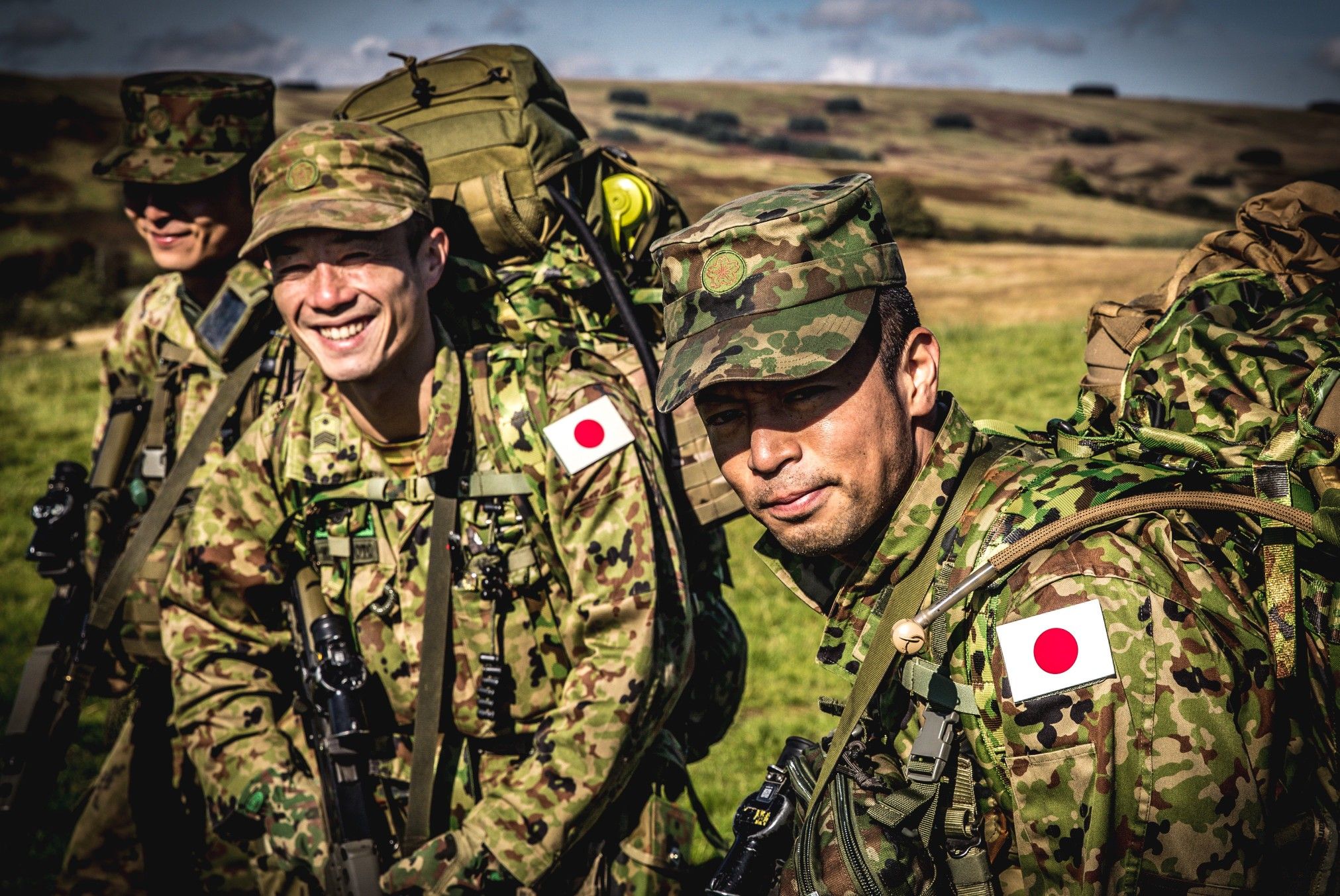
Since 1991, the JSDF have conducted international activities to provide support for peacekeeping missions and disaster relief efforts as well as to help prevent conflict and terrorism.

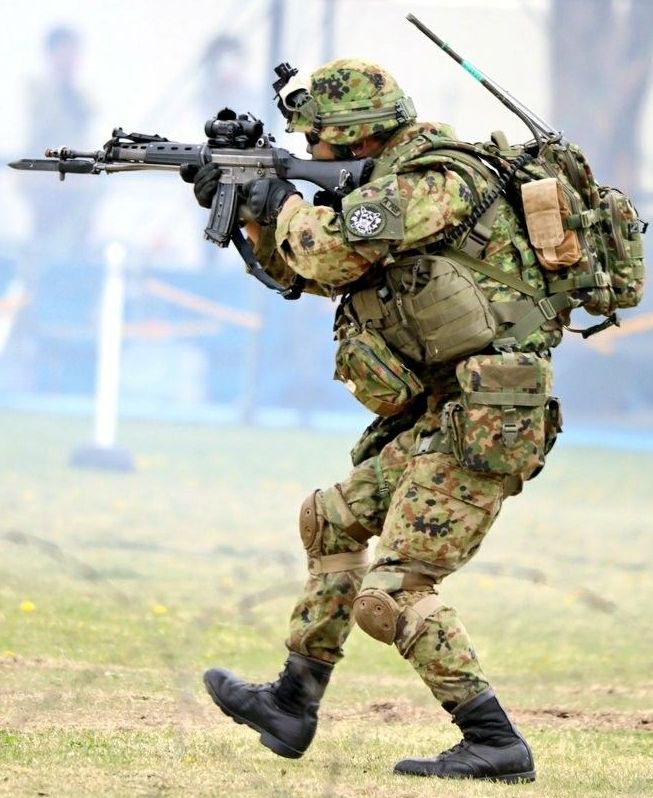
Tensions with North Korea have reignited debate over the status of the JSDF and its relationship to Japanese society. Since the end of the Cold War, the JSDF has refocused from countering the former Soviet Union to the People's Republic of China, and since the 2022 Russian invasion of Ukraine the JSDF has also considered the Russian Federation a major threat; increasing military cooperation with Australia, India, Taiwan, South Korea, Singapore, the United Kingdom, and the United States has been a priority, as well as acquiring new equipment and hardware. With the changes to Article 9 in recent years the JSDF has evolved from a only defensive stance to being able to protect regional allies and participate in oversea training alongside the standard peacekeeping deployments.

The JSDF was originally equipped with a blend of home made equipment and American Military surplus. With the post-war economic redevelopment, the JSDF has since evolved into a sophisticated high tech fighting force.
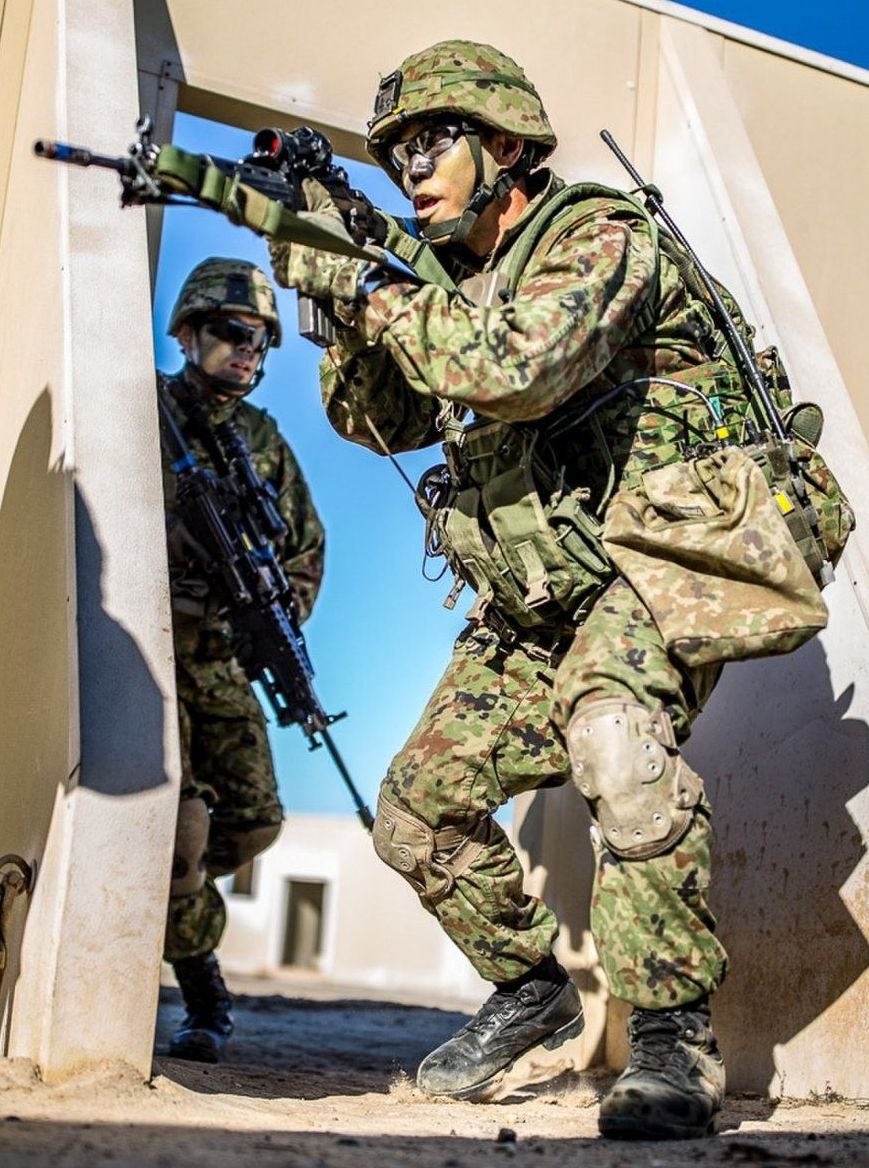
JGSDF Type I was the first camou pattern adopted by Japan after World War II. It was used by the 1st Airborne Brigade and JGSDF Air Defense Artillery Groups in the 1970s–1990s (still in limited use in 2014).
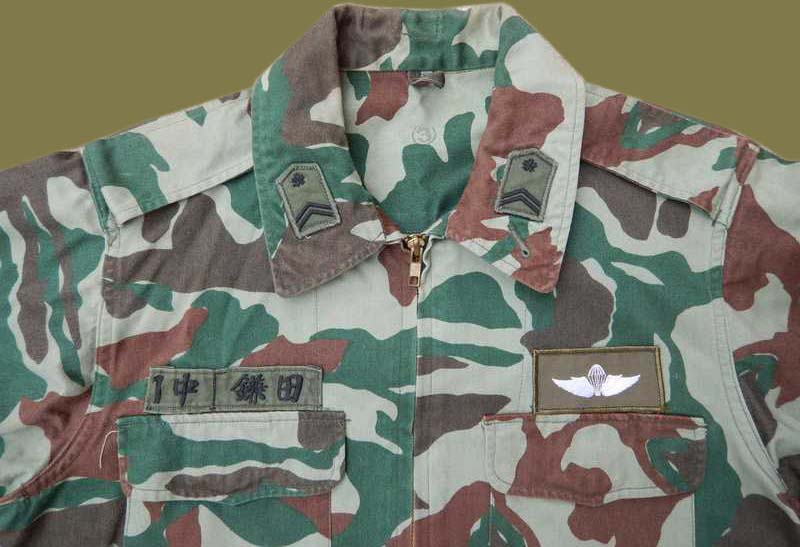
That’s why it is also known as "Airborne Camo" or just "Old Camo".
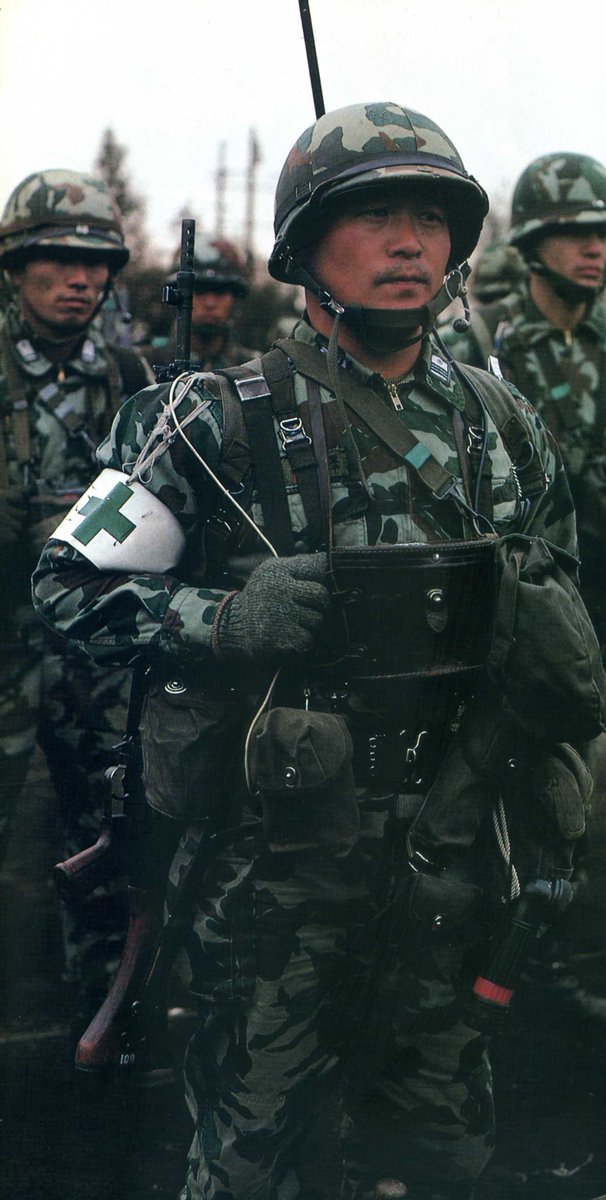
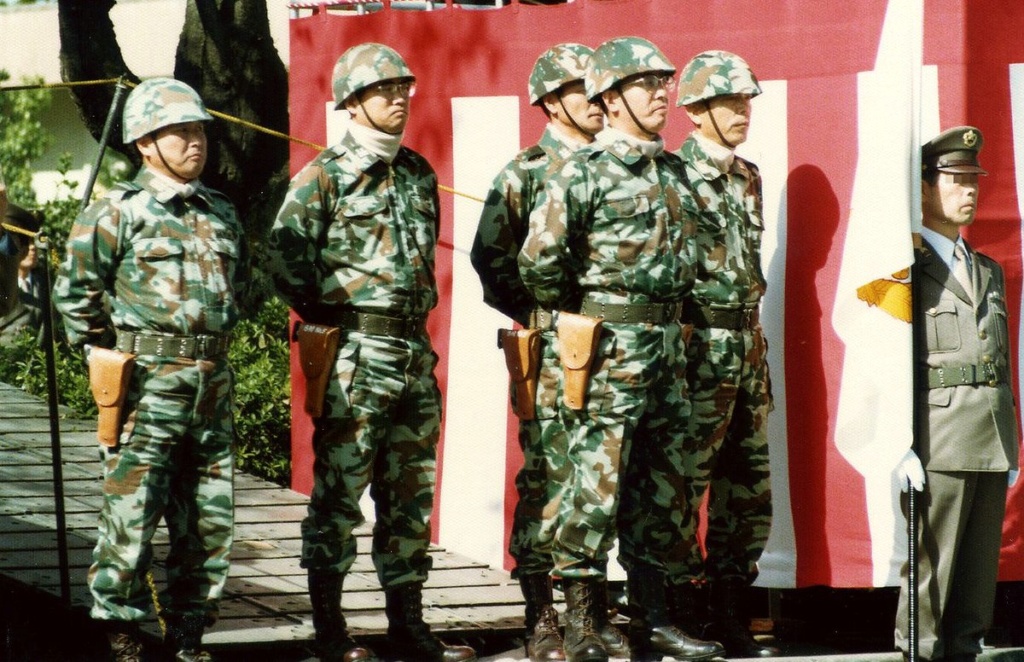
The color scheme of the pattern is based on Hokkaido's wilderness (effective in Sasa veitchii (bamboo) fields), but the shades become distinguishable after wash, and the pattern itself doesn't match to the environment in mainland Japan, leading to the introduction of Type II camouflage.

Type II "Jieitai Dot" (a kind of German "Flecktarn") camouflage (1991-present) is the second domestically designed Japanese pattern, currently used by the JGSDF, the Japan Maritime Self-Defense Force, Japan National Defense Academy cadets, and JASDF Air Rescue Wings Pararescuemen.
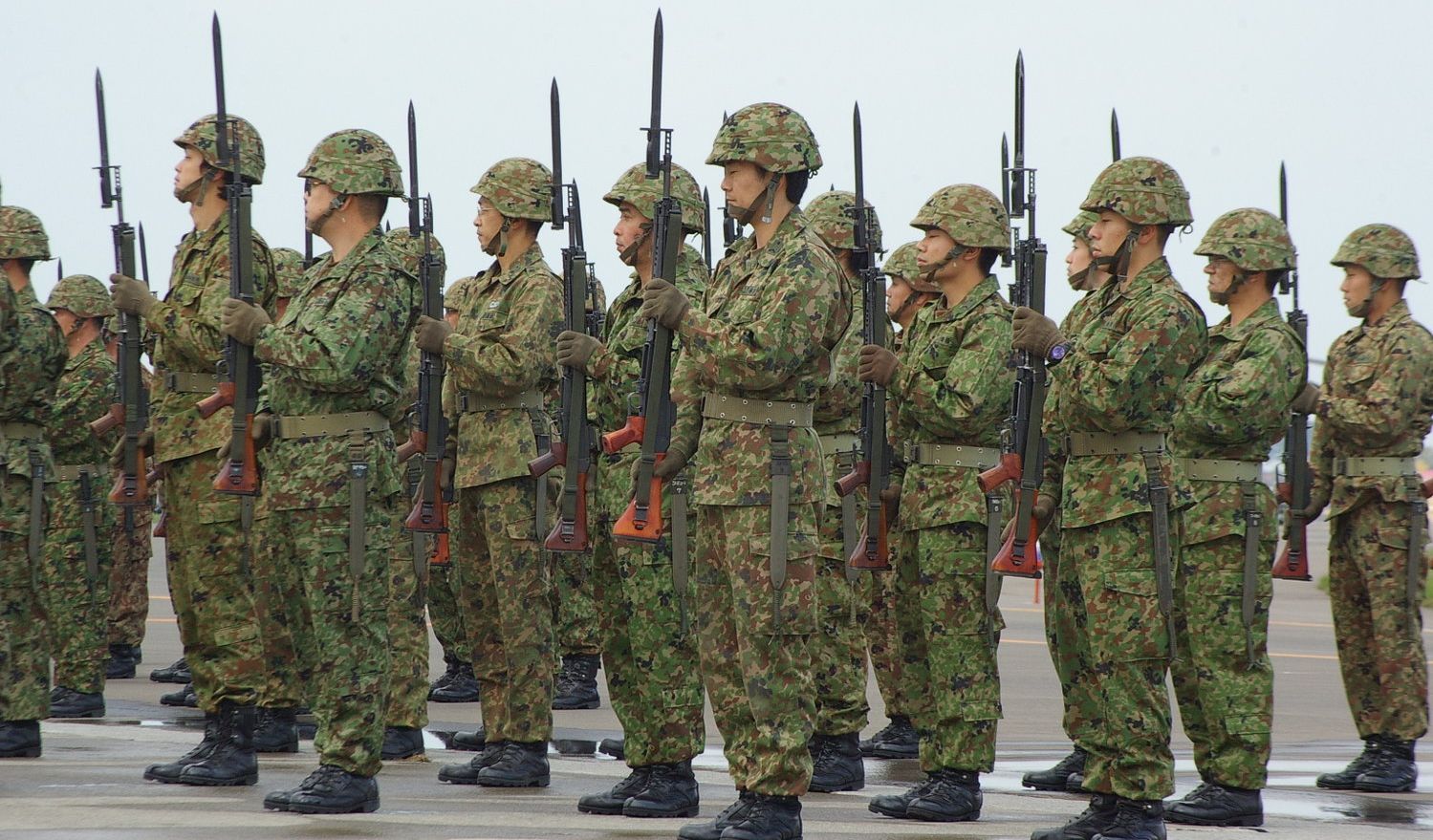
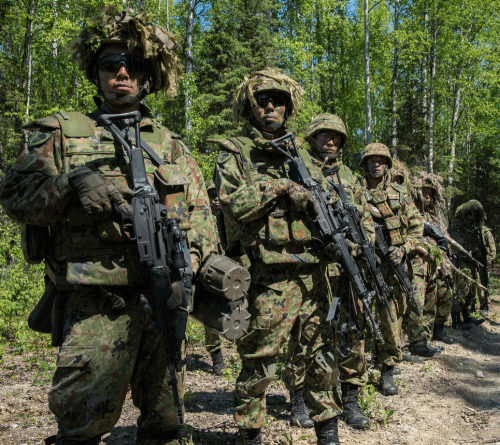
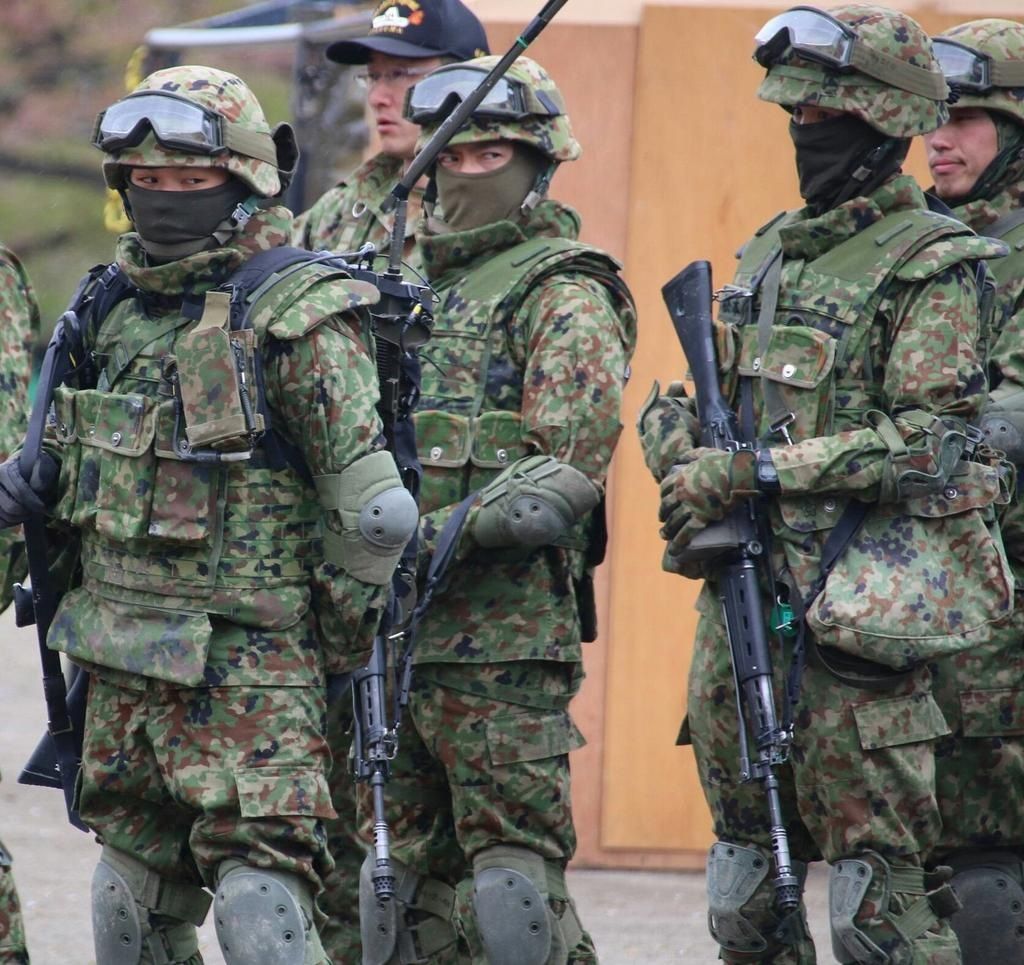
The camouflage scheme consists of dots pattern based on image data of the average vegetation in Japan. The textile is made from 50% cotton/50% vinylon or 70% vinylon/30% cotton. The earlier model had anti-IR/flame-resistant fabric, but the latter lacks the feature.
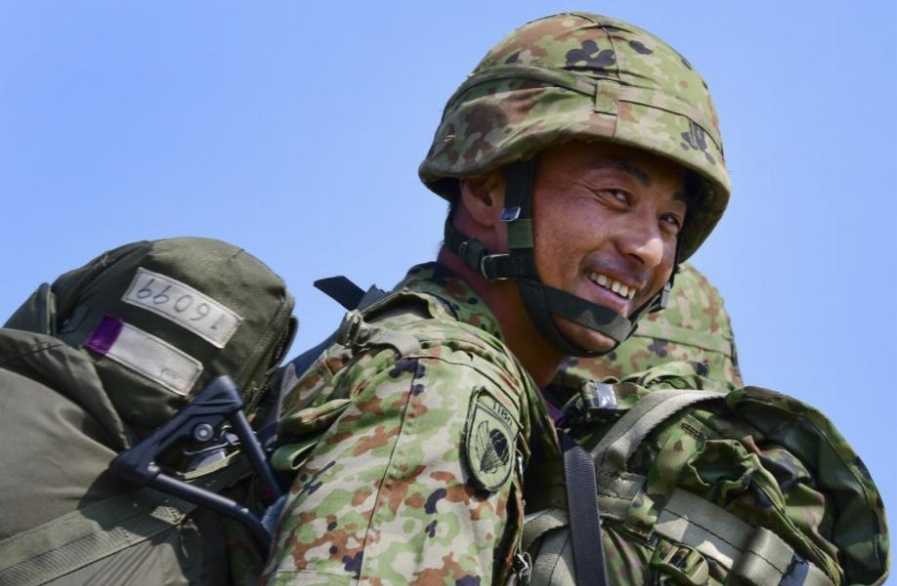
Type II "Flecktarn" brown-dominant winter pattern of the JGSDF (1991–present) is darker in contrast on Type II Flecktarn camo to fit the color of winter plants. It is used on JGSDF Type-2 Camouflage Cold Weather Field Parka and Trousers(防寒戦闘服外衣, 戦闘外被, or shortly 外被).
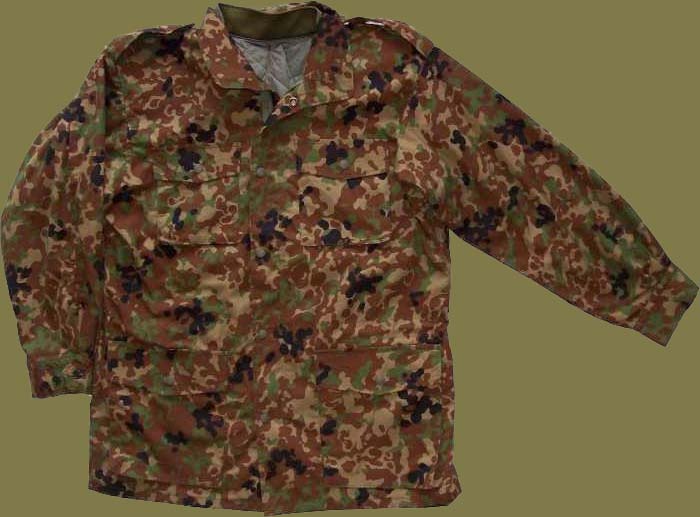
Type III camouflage (adopted in 2007) modified from ''Type II'' pattern features 50% cotton/50% vinylon or 70% vinylon/30% cotton fabric (depending on the year of contract/manufacturer). There were other novelties in this uniform including a change in the front closure, a mandarin collar, Velcro cuffs and pocket lids, wider pen pockets, a loop inside the right chest pocket for ID card chain, two calf storage pockets, and knee pads in the trousers.
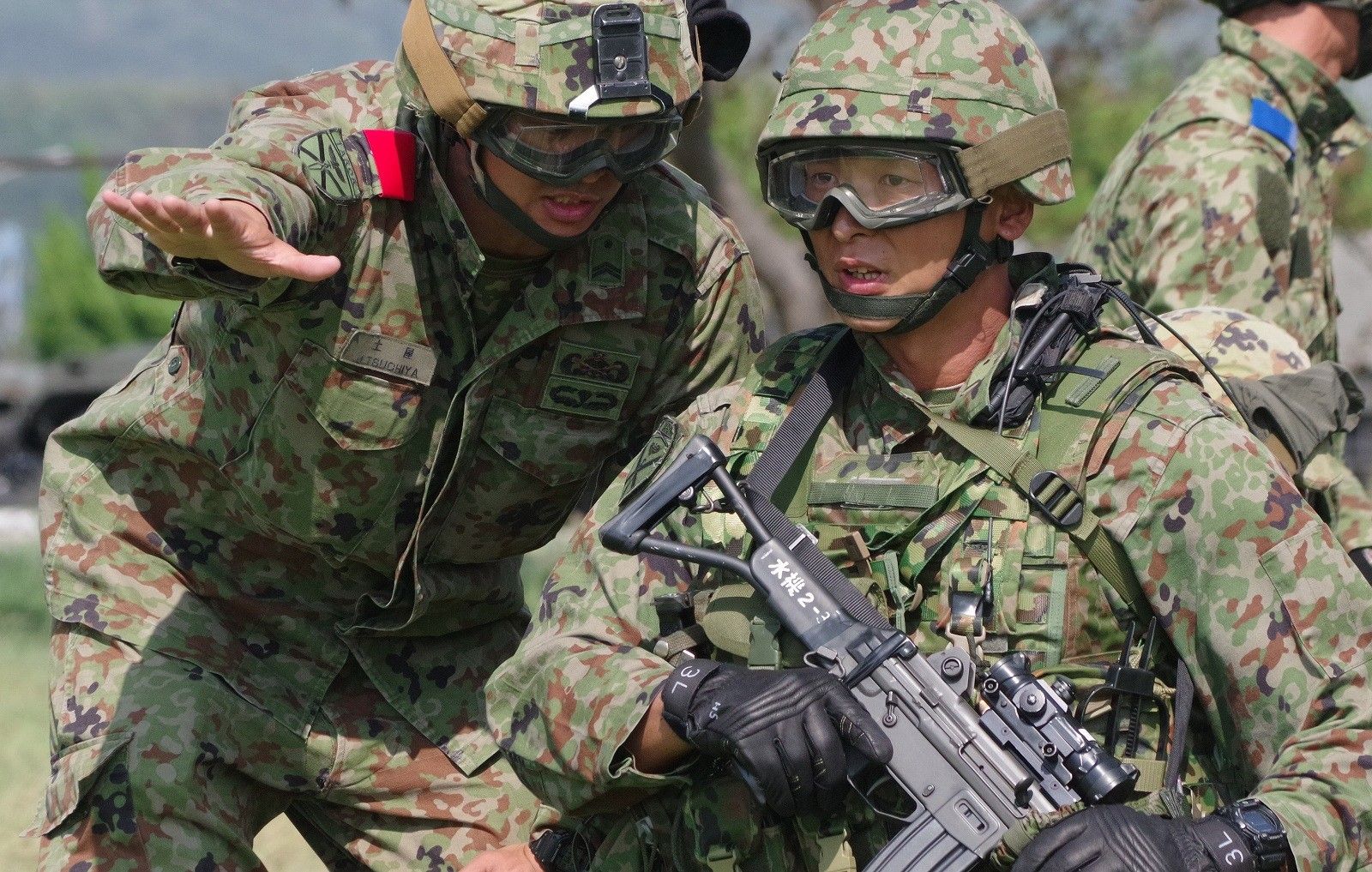

The back pocket on the trousers has been eliminated. The belt (made from the same fabric) comes with a name tag, unlike the former Type II Combat Uniform/Type II Camouflaged Work Uniform.

The Type III Combat Uniform/Type III Camouflaged Work Uniform(戦闘服3型・迷彩作業服3型, or shortly 戦闘服) have the same pattern as the Type II camouflage. Each recruit receives two sets of the Type III Work Uniform after enlisting, and after the boot camp each soldier receives two sets of Type III Combat Uniform, Airborne Uniform or Tank Uniform, depending on the troop where the soldier belongs to. The Combat Uniform and Camouflaged Work Uniform are identical to each other, except for the product tag. Commercial version of the item (100% polyester version, cotton/poli version etc.) is no longer authorized to be used, including the vinylon/cotton fabric version. The use of commercial combat cap in vinylon/cotton fabric is authorized. The commercial versions have slightly different shades.
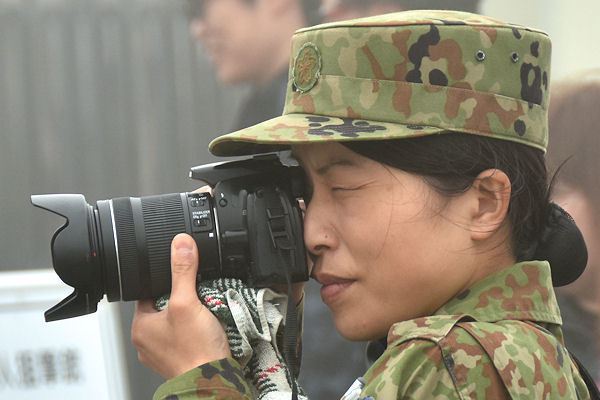
One can not help mentioning the current JGSDF Desert camouflage adopted in June 2010 for Middle Eastern deployments.
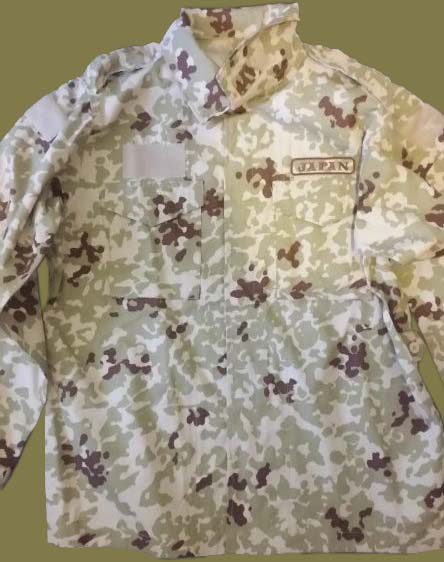
This camo is a desert version of the JGSDF's "Flecktarn pattern". The first unit using this particular camouflage was the Central Readiness Force during the 4th DAPE (Deployment Air Force for Counter-Piracy Operation) in the Gulf of Aden. Now this camou pattern is used by JGSDF International Peace Cooperation Activities Training Unit and JGSDF Central Readiness Force.
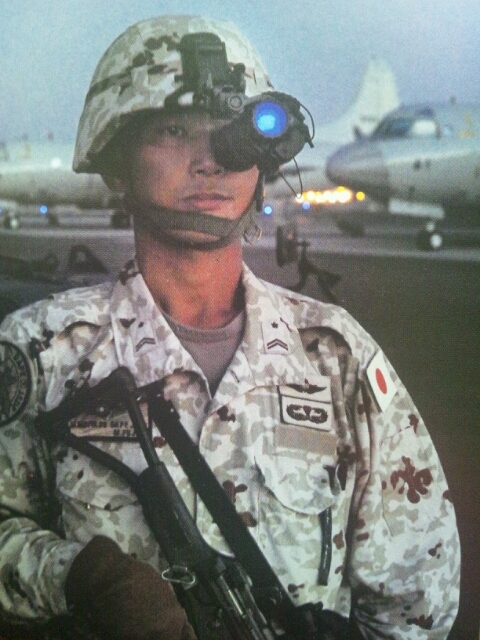
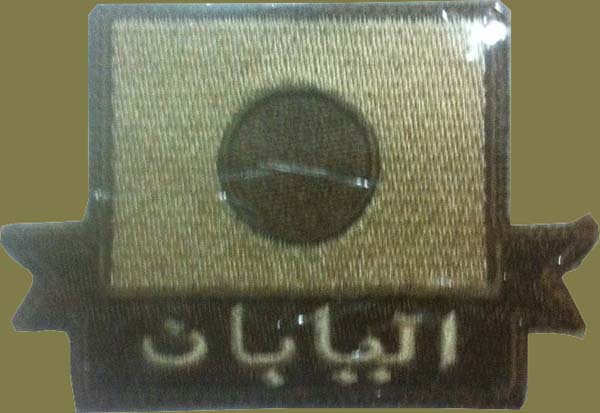
There are 3 main kinds of the Japanese combat uniform and boots
1) Officially issued Uniform. It should obligatory have the "Sakura" Symbol, production date. manufacturer's name and NSN-numbers on label. It is very hard to find and buy such products on the civilian market.
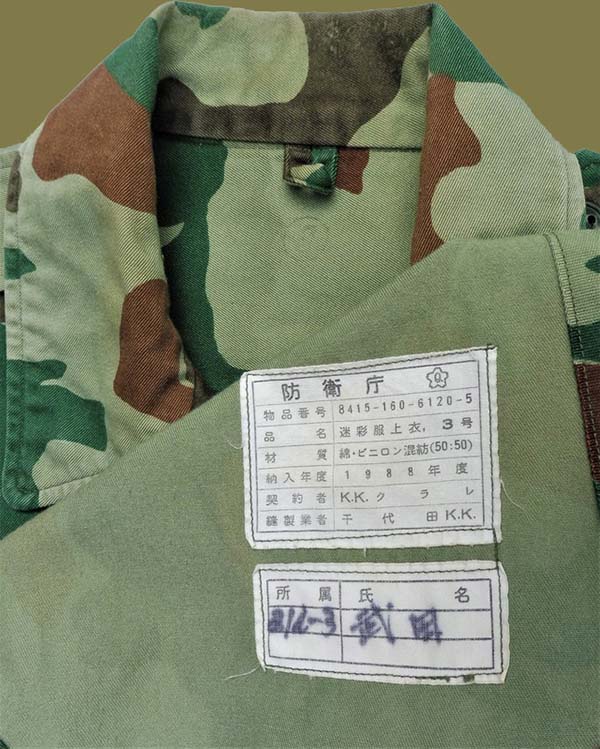
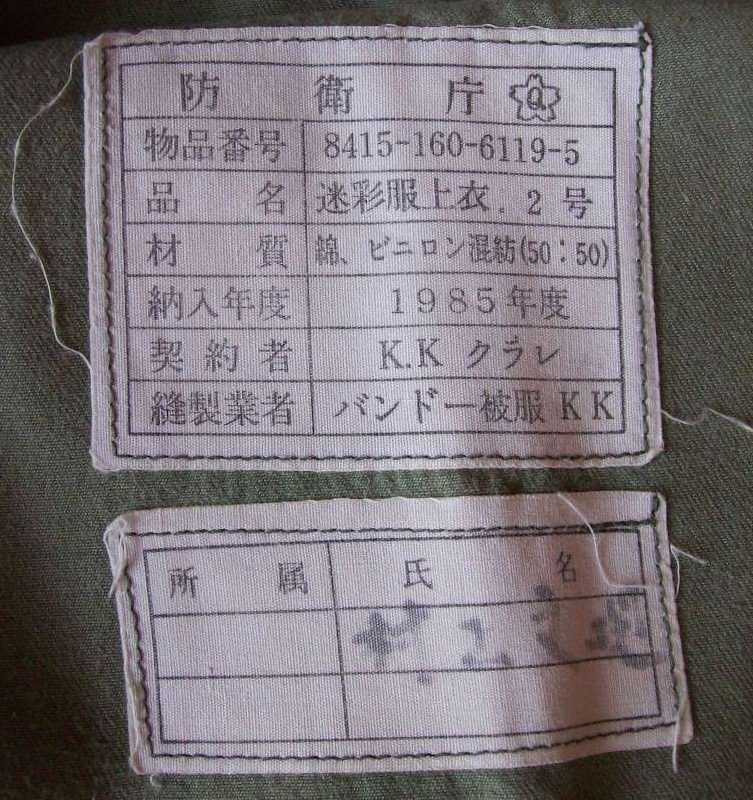
2) Private purchased uniform. Only the active JSDF members can purchase this uniform through their logistics chain. Basically there is no difference with officially issued one, but the label. No NSN- Nnmbers on label. Otherwise it is the same as officially issued one. It is pretty hard to get this uniform too and prices are relatively high.
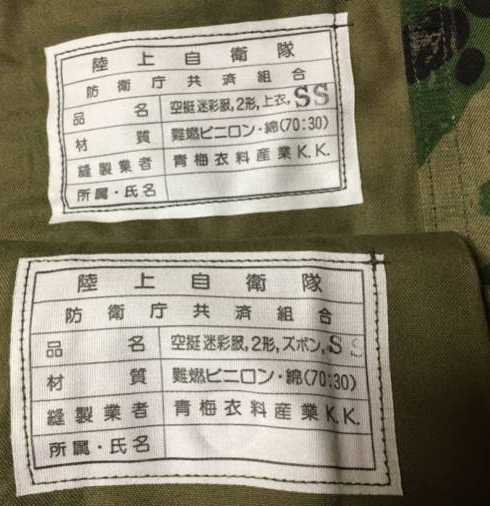
3) Commercial versions of the uniform. This is the most common uniform on ebay or collectors. There are several variants out there and NO NSN-numbers or manufacturer's name, just size stamp and blank white label for owner's name and unit. If you visit Japan someday, you can purchase new one and any size at Military store, even the JSDF members use to wear this uniform (and boots) frequently, but still these are commercial piece, although colors and stitching are pretty decent.

Some curious facts about the Japanese military uniform and peculiarities of its wearing:
- Name Tags. Unlike the new rank/skill insignias (in green shade of the current camo), usually the name tags are in OD of Type 65 Work Uniform.
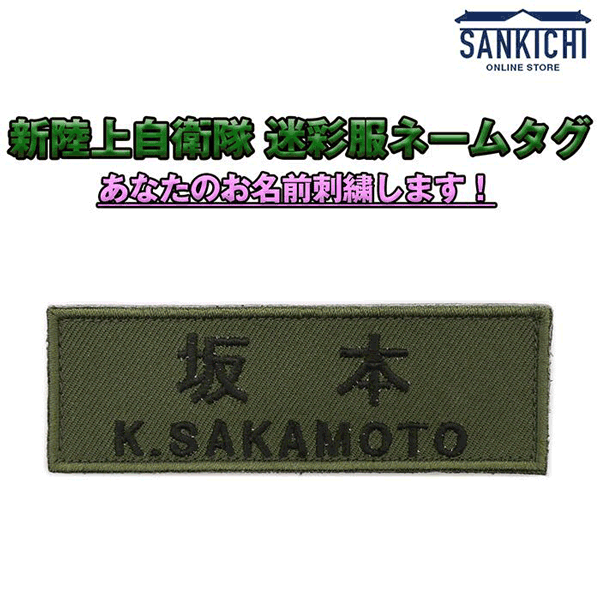
Since the army regulation doesn't mention about the name tags, each unit has its own regulation for the tags. Therefore, the layout, length, font, letters (Japanese or Latin alphabets), place of wearing, how to attach the tag (either sewing or using velcro) etc. vary. Some troops do not use name tags for winter jackets.
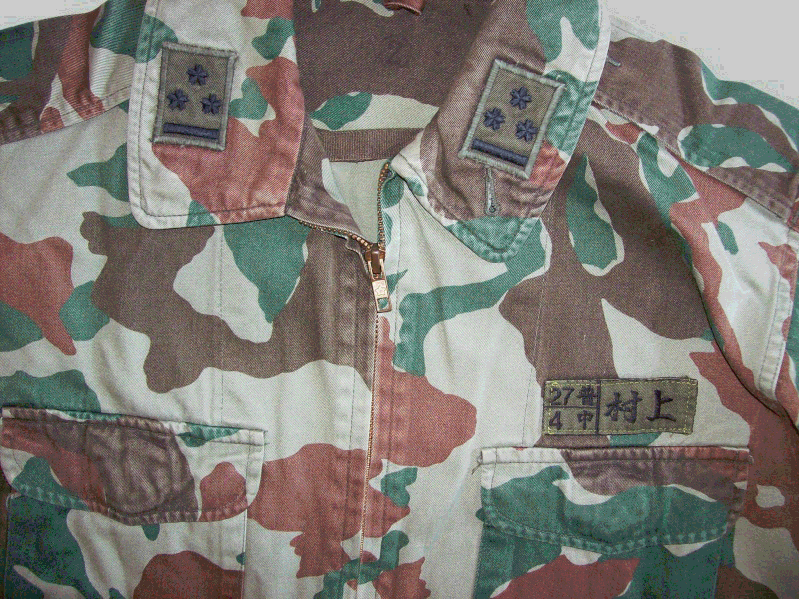
- Tracksuits and running shoes. The recruits are demanded to buy their own tracksuits and a pair of running shoes, upon the enlistment. There is a uniform code called "ジャー戦 (Jaasen, literally jersey and combat uniform)", which is composed of combat jacket, combat cap, trackpants and sneakers. This uniform code is often used in the boot camp for jogging, eating in canteen or going to bath, since it's easy to identify the name and the troop of the recruits. Any trackpants and sneakers are permitted for the code, for instance, it is possible to wear the following items: Nike Air Force 1, Adidas Superstar trackpants etc.
- Underwears. Each Japanese soldier has to purchase his own underwears. A khaki flame-resistant T-shirt, a part of Combat Underwear Type 2 set is usually issued only one and mainly used for ceremonies etc.
- Baseball Cap (部隊識別帽). Many troops use baseball caps with the troop's logo instead of the issued combat cap. Since it is unofficially introduced, each soldier has to buy it by him/herself. There are no standards for the cap, although, in many cases the cap has the soldier's family name on top of the left ear.
- Carabiner. May be purchased individually, to attach it to the either right or left waist tab on the combat uniform to hang gloves or combat cap.
- Shoulder Pouch. May be purchased individually, since the combat uniform doesn't have shoulder pockets. There are various commercial versions. Some troops use the velcro version to attach unit patches, insignias etc.
- Cold-Weather Combat Uniform Inner (Under). A long-sleeved shirt and matching pants, made from thin synthetic fabric, often referred to as "カエル (frog)" from the fabric's fluorescent green.
- Cold-Weather Combat Uniform Inner (Outer). Acryl sweater and matching pants, comes with a buttoned collar which is worn folded, often referred to as "バッタ (grasshopper)" from its color.
- Cold-Weather Combat Uniform Middle Layer. Often referred to as "宇宙服 (spacesuit)" from its shiny and bulky appearance.
- Work Jacket. Issued as personal item. Intended to be used in cold seasons over the work uniform. Features two chest pockets and two lower pockets (with flaps without closures). Despite of the fact that the item is a cold-weather jacket, the camo version somehow contains hemp fabric, and is hoodless. Since the cold-weather combat jacket is warmer, rarely used in many troops.
- Combat Rainwear. The same item is issued as personal item(not as Combat Loading Set) but with a different name (Compact Rainwear Type 3), often mocked as "Shimitex(soak-tex)" or "Nisetex(sham-tex)", due to the poor water-proof coating which disappears after several use.
- Combat Bullet-Proof Vest. Storaged as weapon, instead of personal belonging, introduced in 1992. Comes with ammo pouches which aren't used to prevent damaging. In some troops Type 2 bullet-proof vest and/or Type 3 bullet-proof vest are issued.
Japan Ground Self Defense Force (JGSDF) boots, Brown (Type 1)
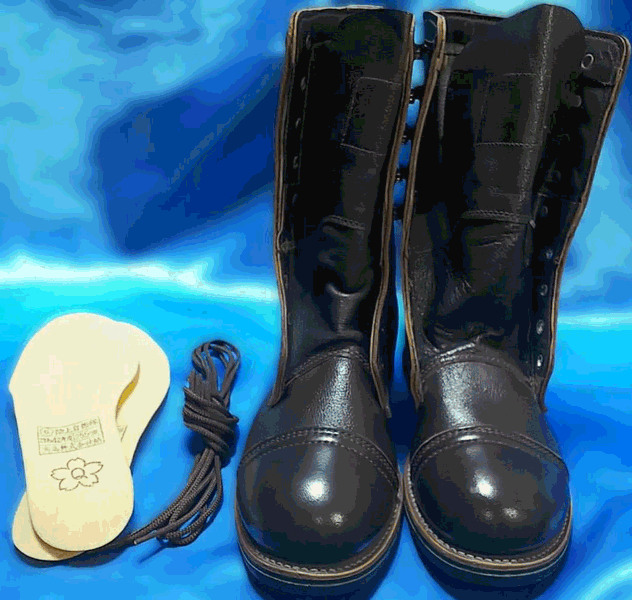
The early Japanese military brown boots model was based on the 1940s model of American paratrooper boots (the so-called "Jump boots"). This was done by many post-war US allies, and an example is the Dutch military boots model M/57, which were made in exact accordance with the American specification of red-brown army boots of 1948 - "M1948 Boots, Service, Combat, Russet".
Characteristic differences of this model are reinforced toe and heel areas (additional leather overlays).
Additional leather strip is sewn on the inner side of the lacing system and the top of the shank for cushioning, tighter coverage of the leg and retention of uniform pants tucked into the boots.
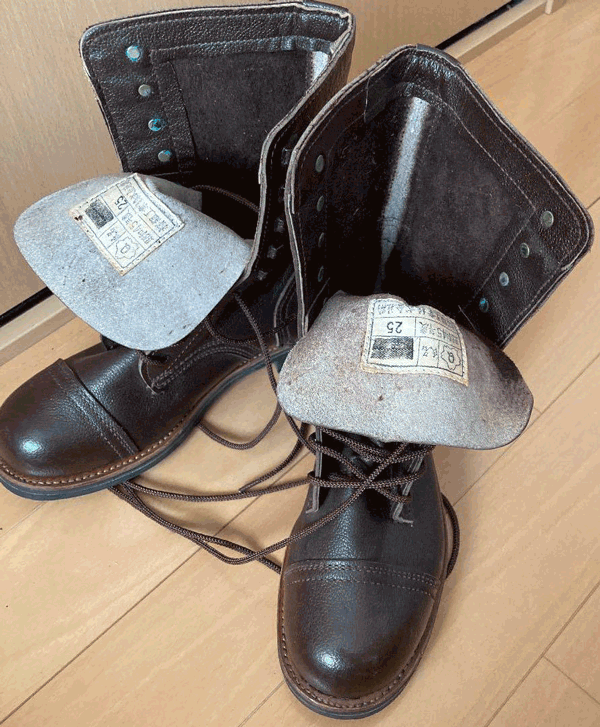
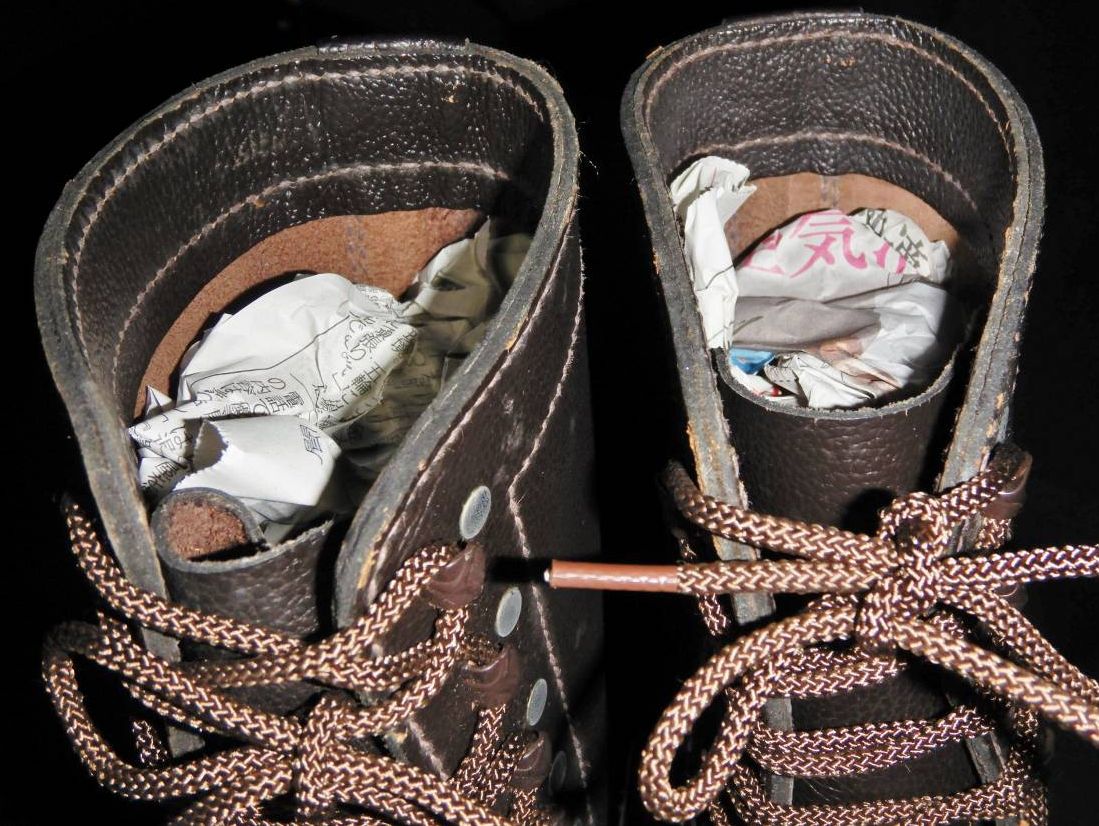
The leather upper is processed by the "shagreened" technology with fat impregnation. The height of the boots is 25 cm.
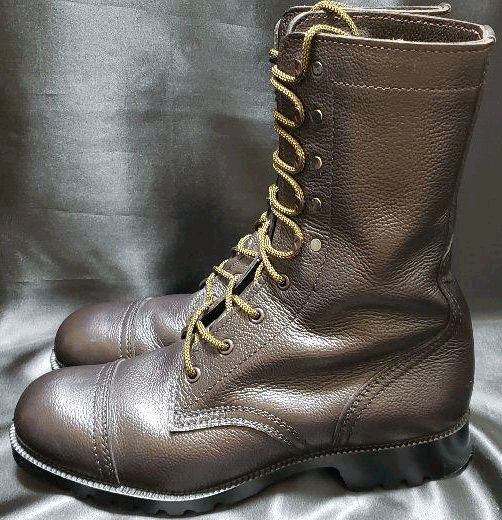
The sole of these boots is made of thick cowhide leather with rubber tread stitched through and glued, padded with shoemaker's nails.
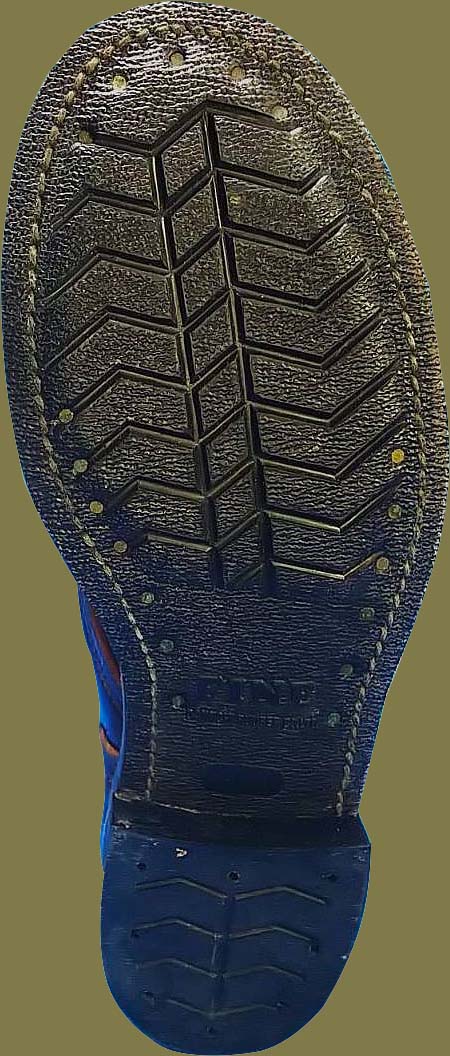
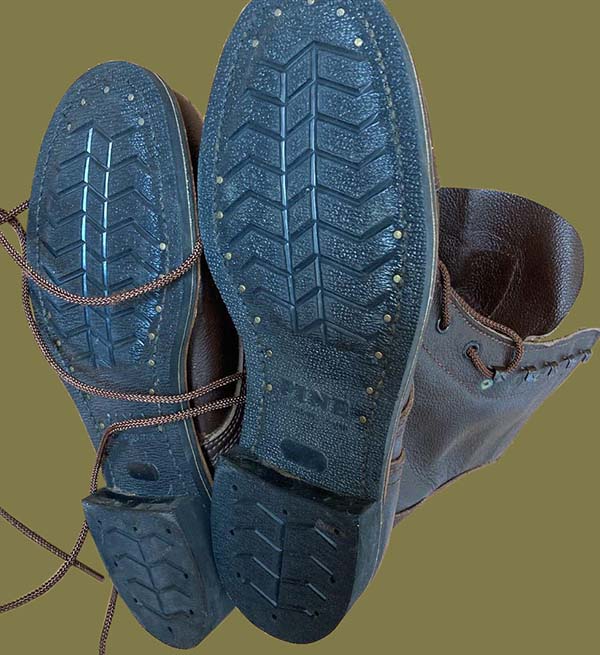
The Japanese boots have all this, but the lacing system has been modified: leaving 4 pairs of simple round eyelets at the bottom, the upper part of the lacing consists of 5 pairs of hooks.
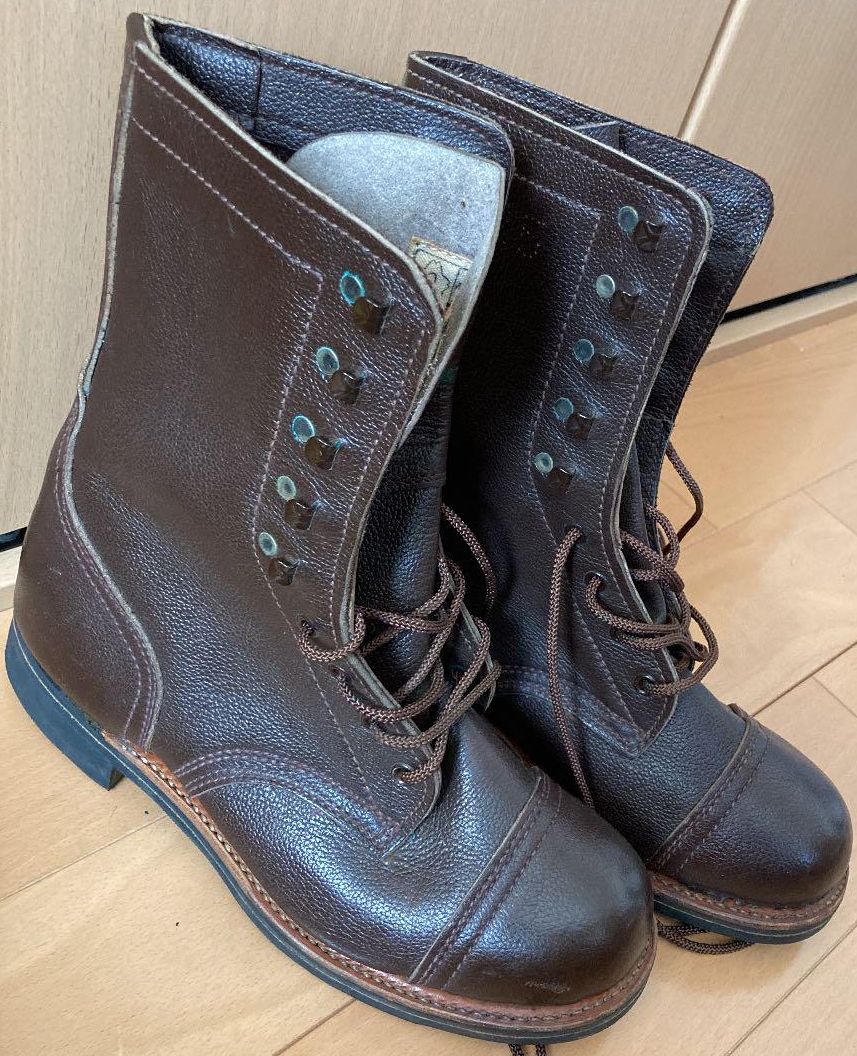
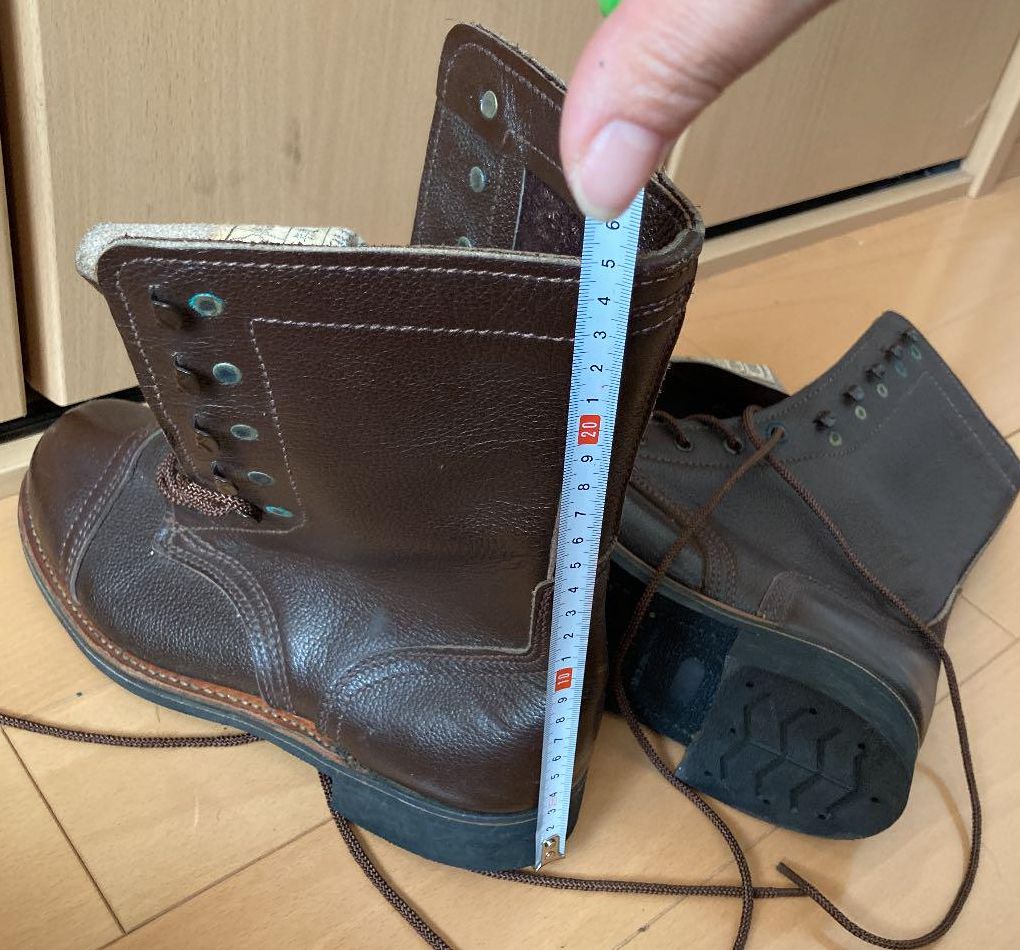

This is a rather unusual design, not found on boots of other countries: the hook is attached between the layers of leather, only the hook and rivets of the fasteners protrude outside.
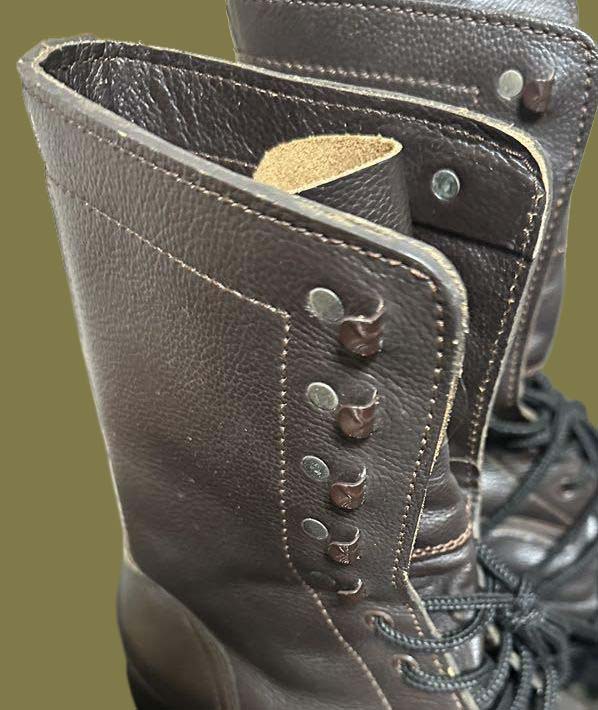
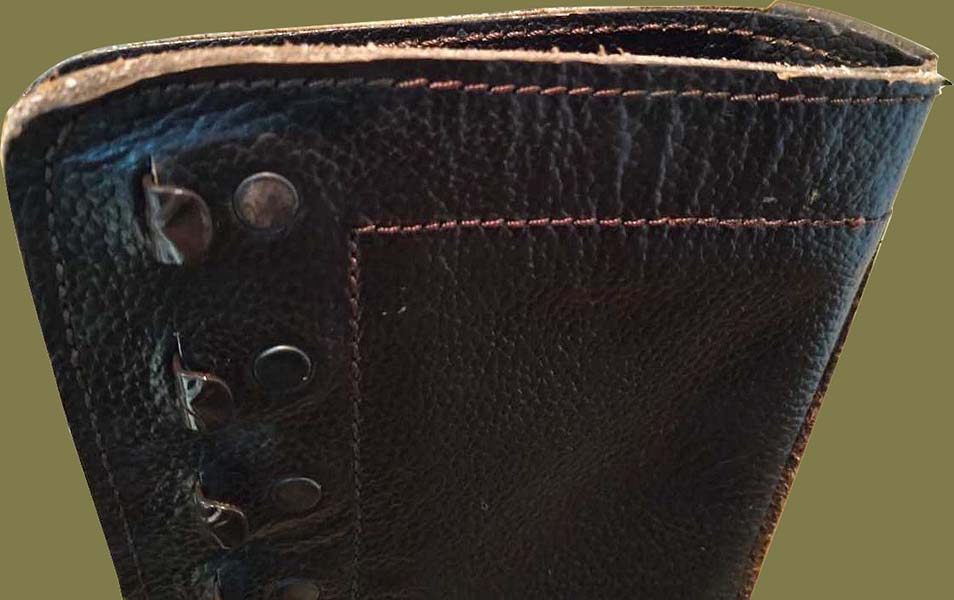
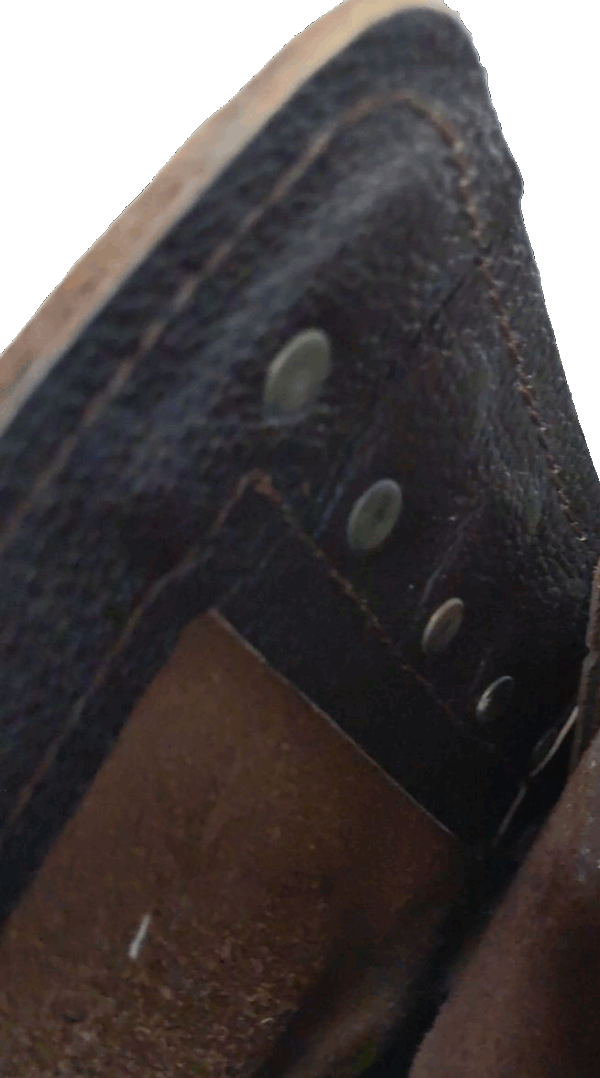

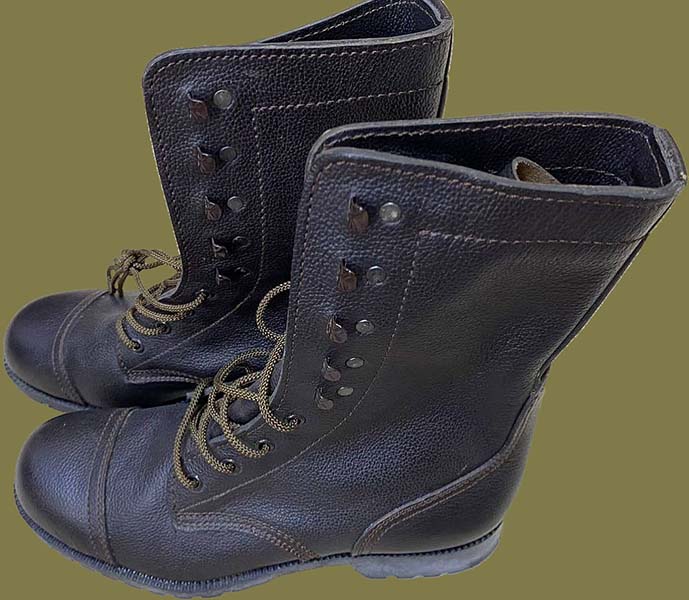
Тhe sole attachment method is "Goodyear welt construction". The soles of boots can be replaced with Vibram soles or similar in function, and this is appropriate for older military boots with well-preserved leather uppers but potentially problematic (due to long storage) rubber or polyurethane soles.
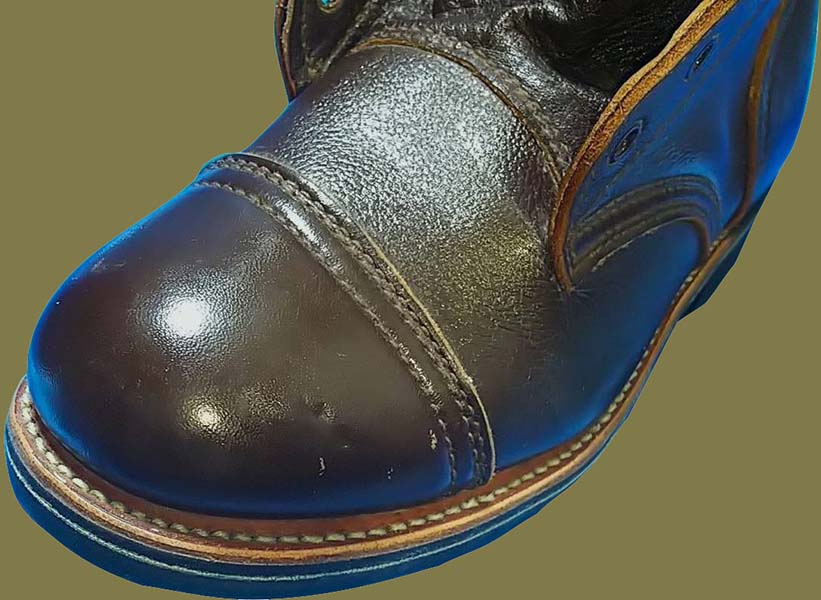

The size is listed on the label and is duplicated by dot perforations on the upper inner side of the shank. Newer types of Japanese military footwear no longer use this method of labeling due to the use of linings and damping inserts.
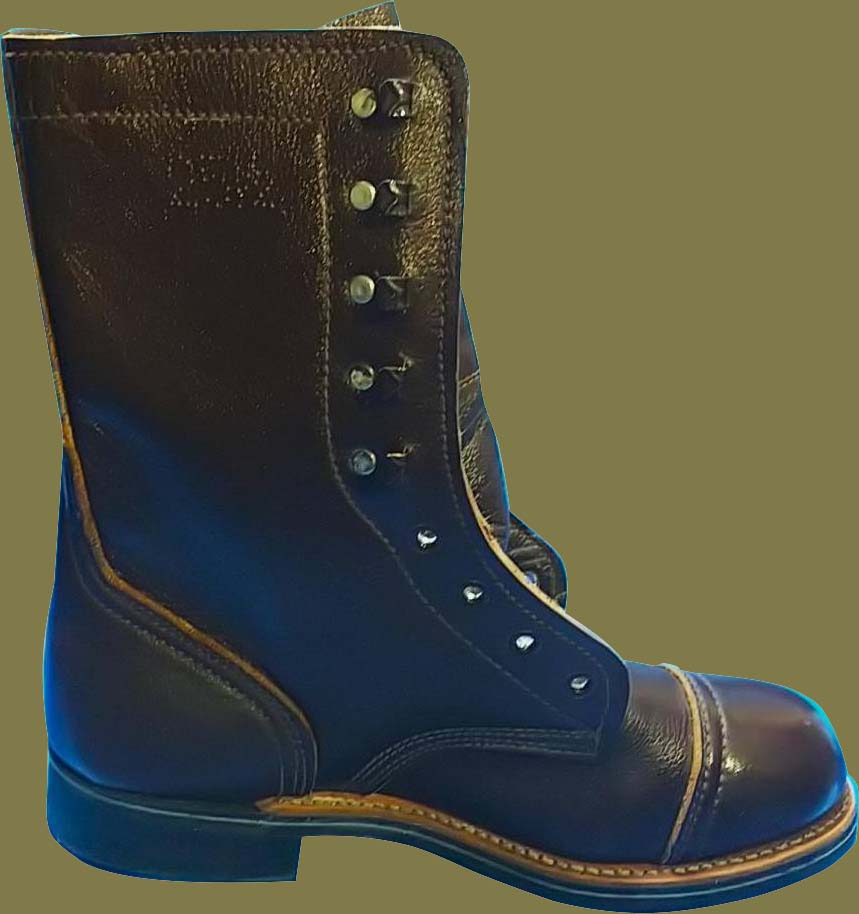
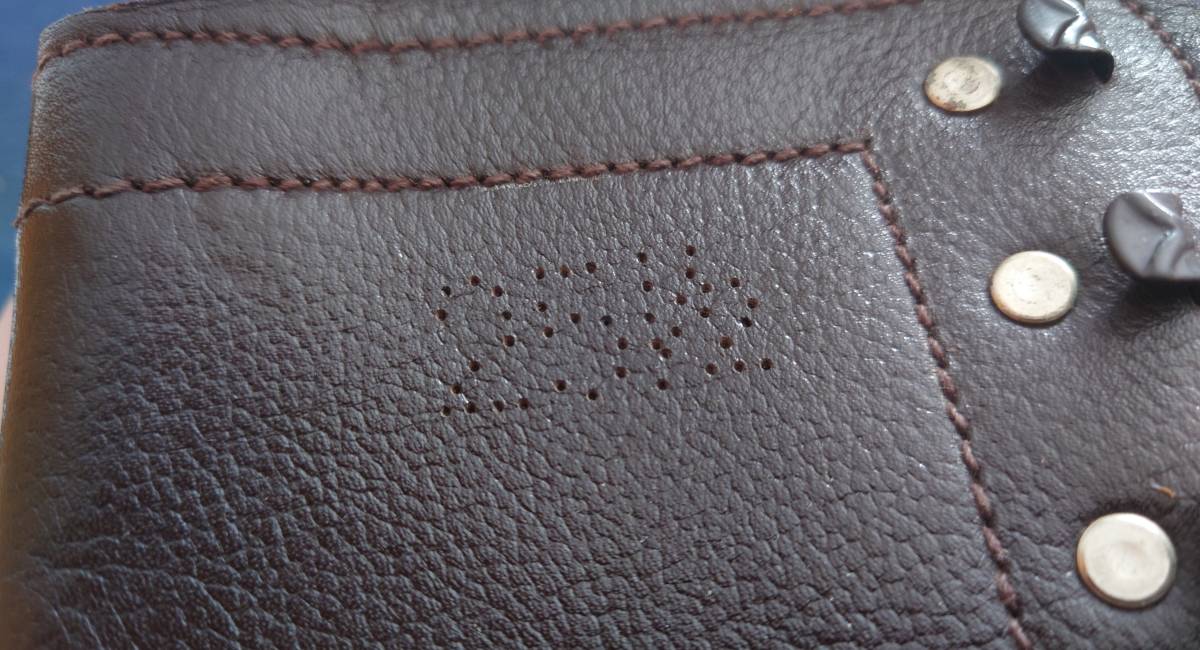
The Japanese have their own, characteristic and recognizable tread pattern of the sole, of the "chevron" type, like the old boots of the USA, Israel and Norway, but with a shallow grooving and breakdown into angular zigzags and rectangular parallelepipeds in the center of the foot and on the heel.
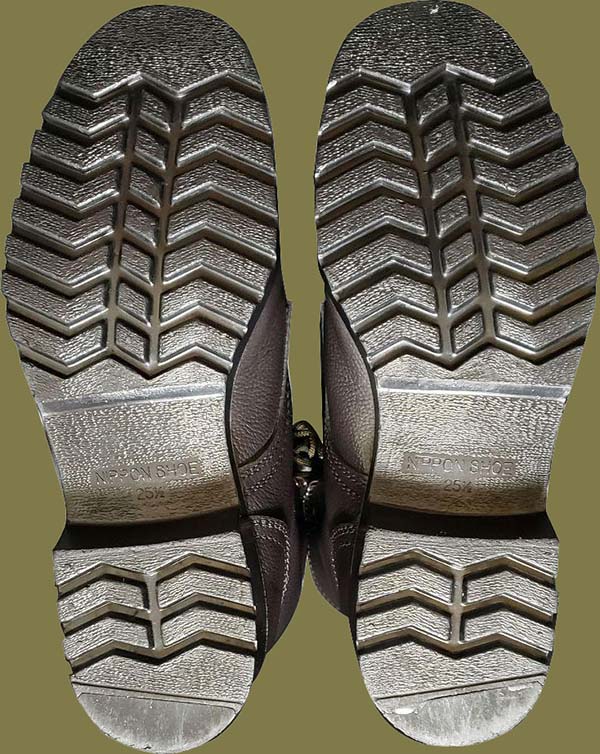
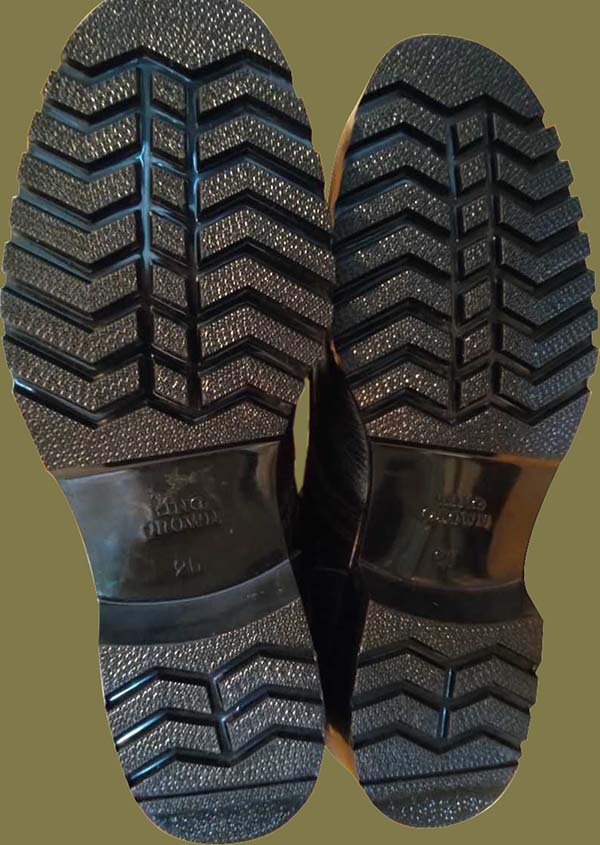
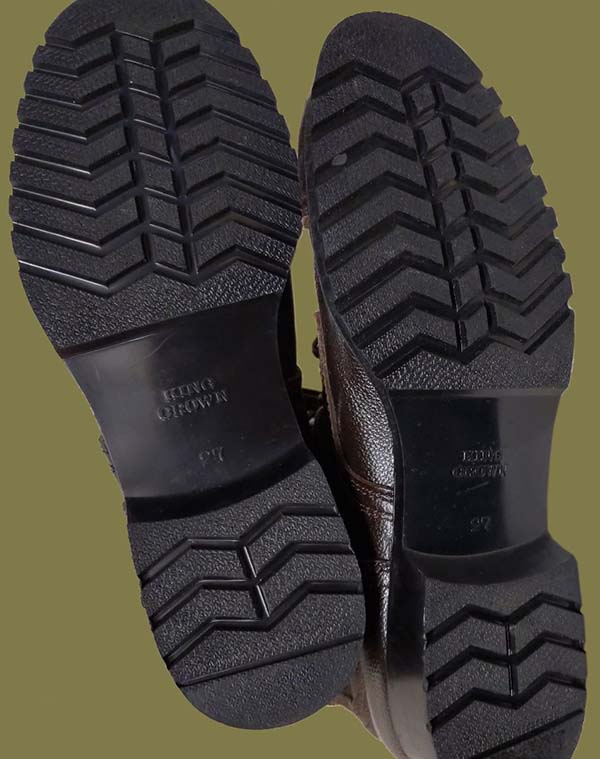
Glue-stitching method of fixing the sole - quite labor-intensive, although it has the undoubted advantage of repairability and ease of replacement soles. Since about 1970s, the Japanese began to produce an updated version of brown boots with a "tidal" method of fixing the sole (DMS - Direct Molded Sole).
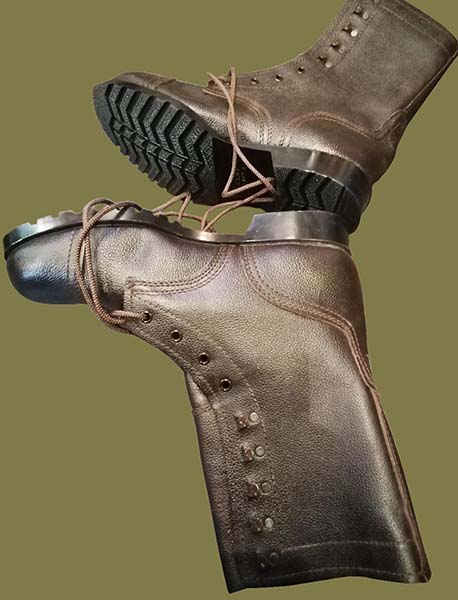
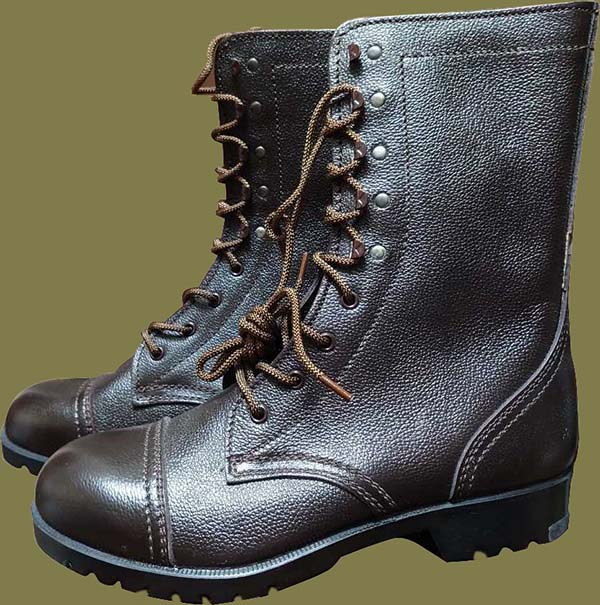
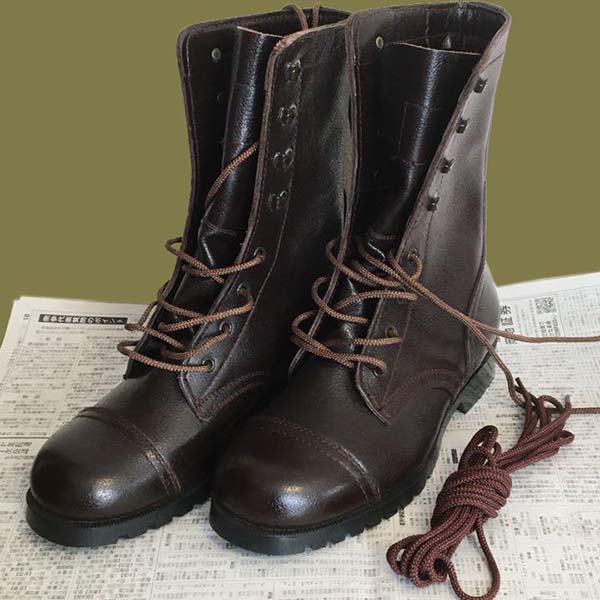
Such a sole is very strong, hard, the tread pattern basically retained its shape and became deeper.
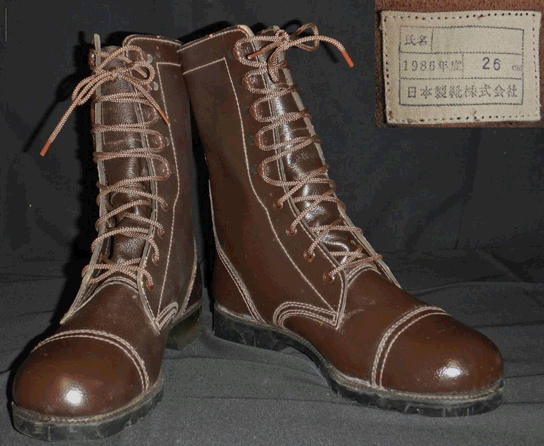
As mentioned earlier, all Japanese military products are necessarily marked with a logo - a sakura flower and the letter "Q" inside it.
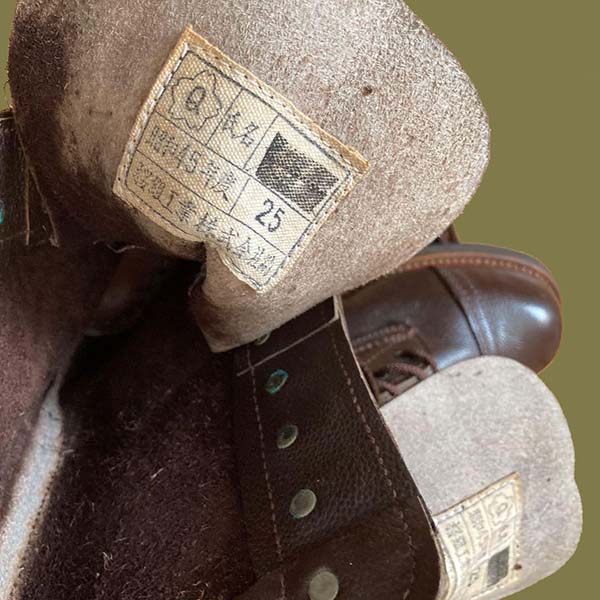
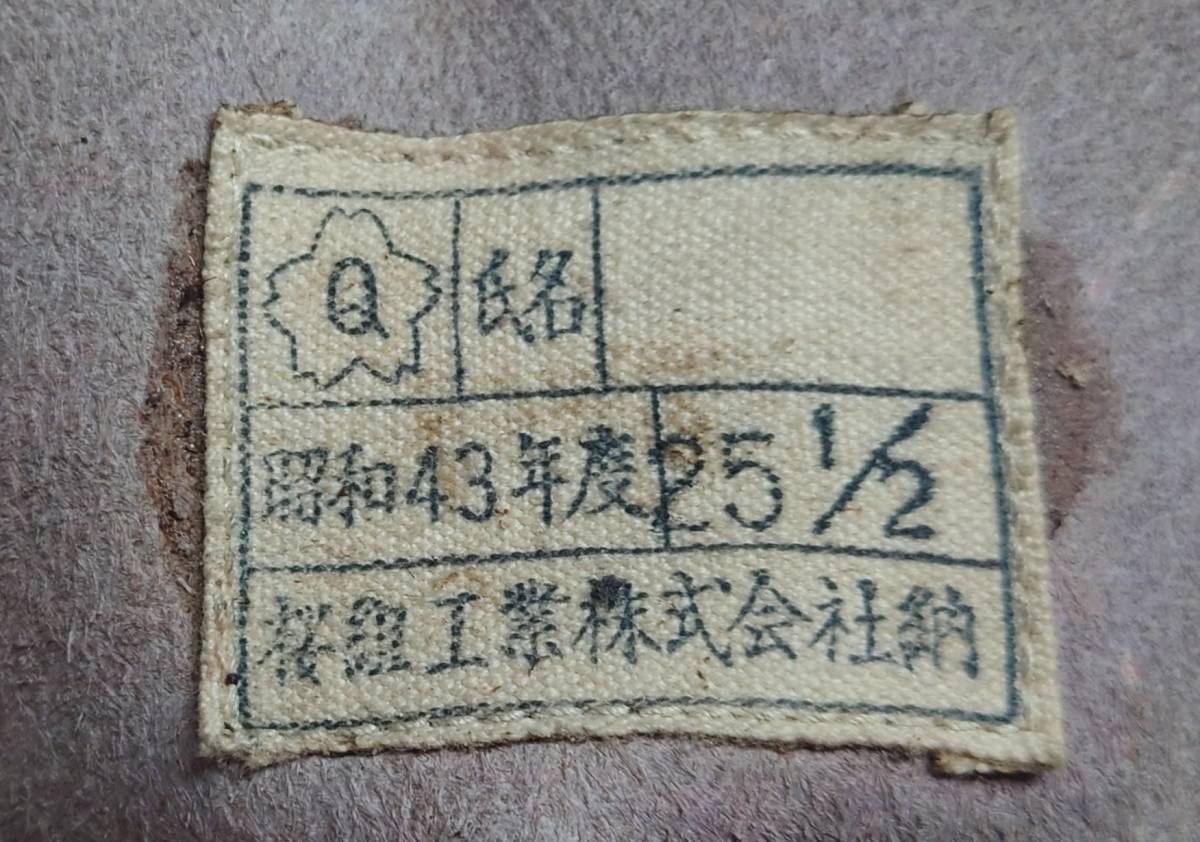
On Japanese Internet sites there are many boots that look quite high quality and fully correspond to the appearance of military boots, but do not have such a logo - these are commercial products of the same companies producing uniforms and footwear, which produce contract products, but for the civilian market.
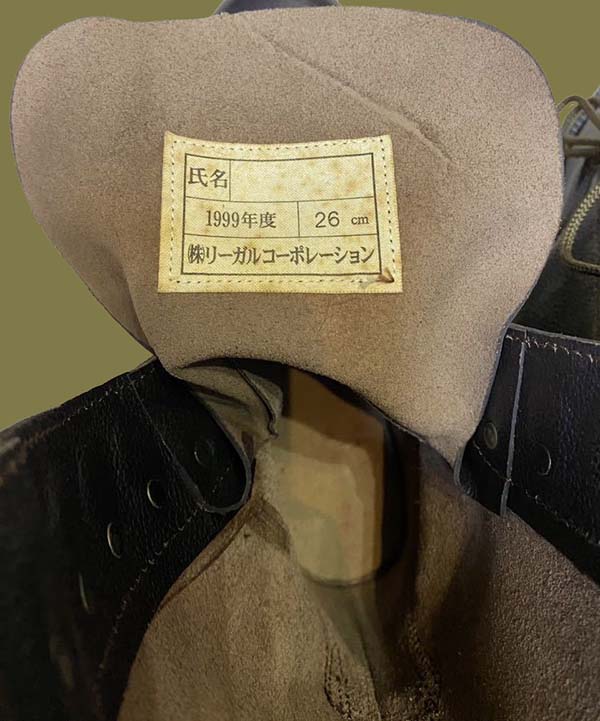
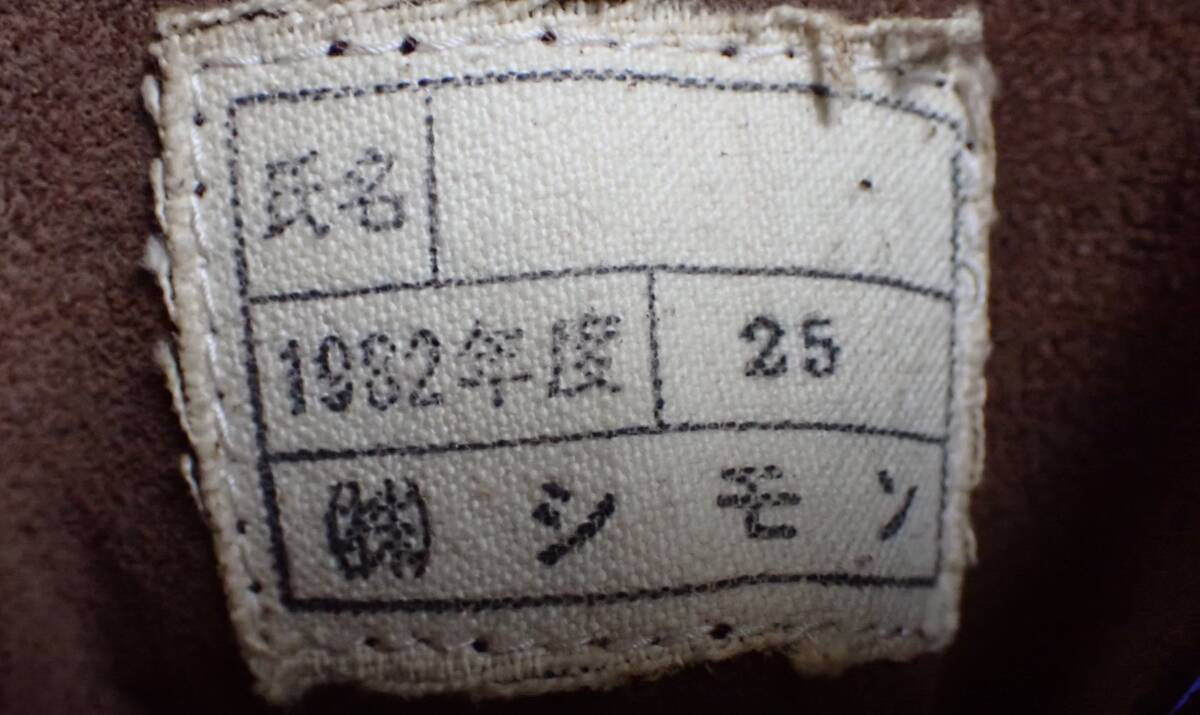
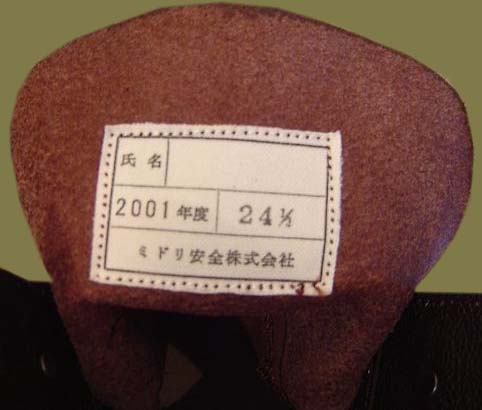
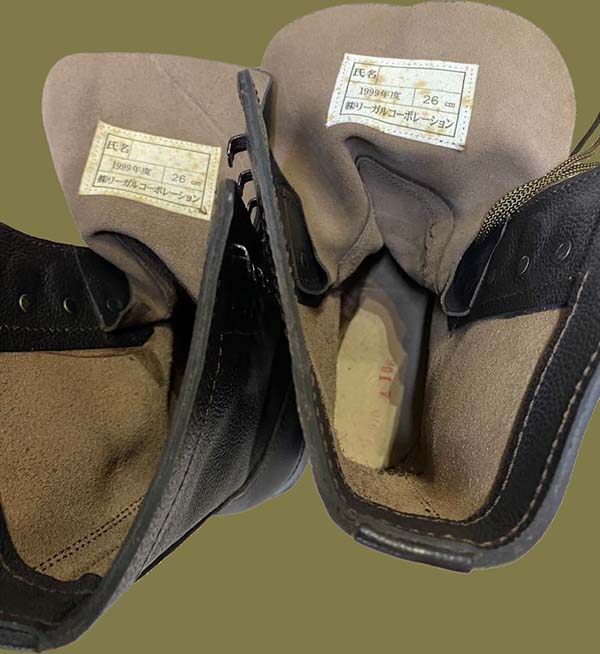
Since such products are also authorized for use by the Japanese military (the main thing is the appearance corresponding to the military regulations), such boots are bought at their own expense, and this rule applies to all types of Japanese military footwear and uniforms.
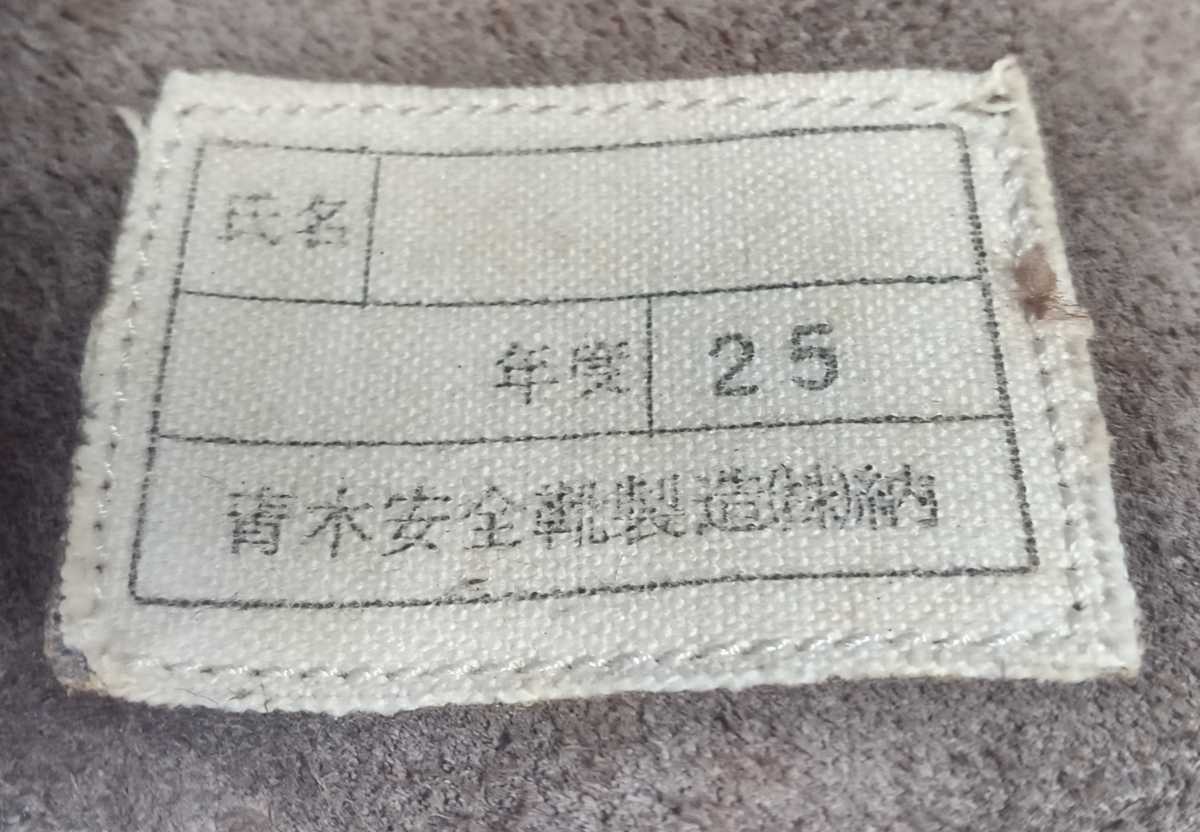
Among the most common contract manufacturers of Japanese military boots (also supplying similar products to the civilian market) are: "Sakuragumi Kogyo K.K.", "FINE", "Takashima KK", "Nippon Shoe", "King Crown", "Simon", "AOKI Safety Footwear ", "Midory Safety Footwear" and others.
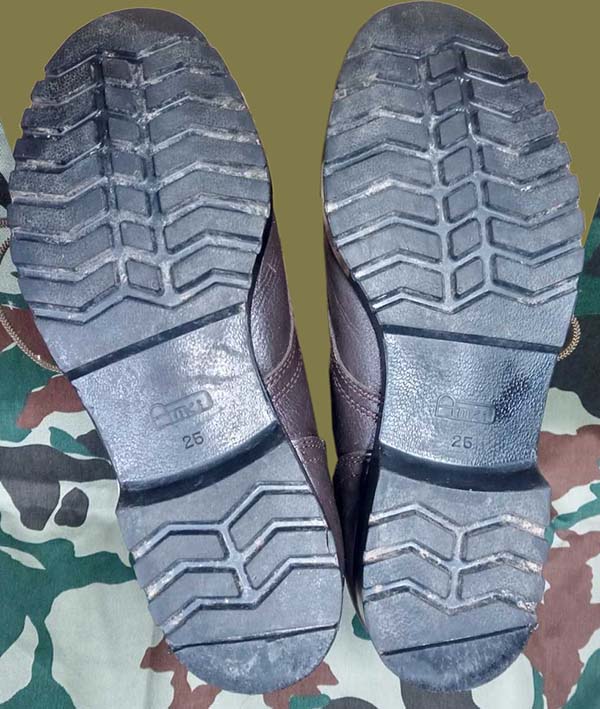
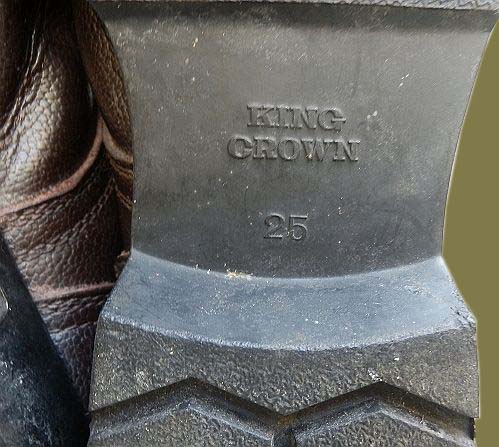
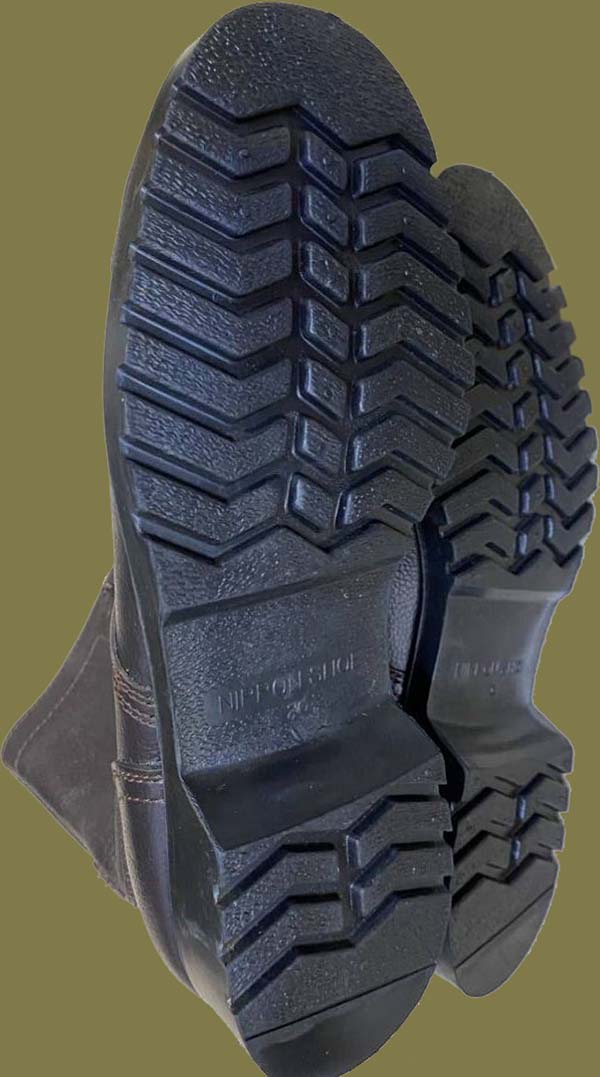
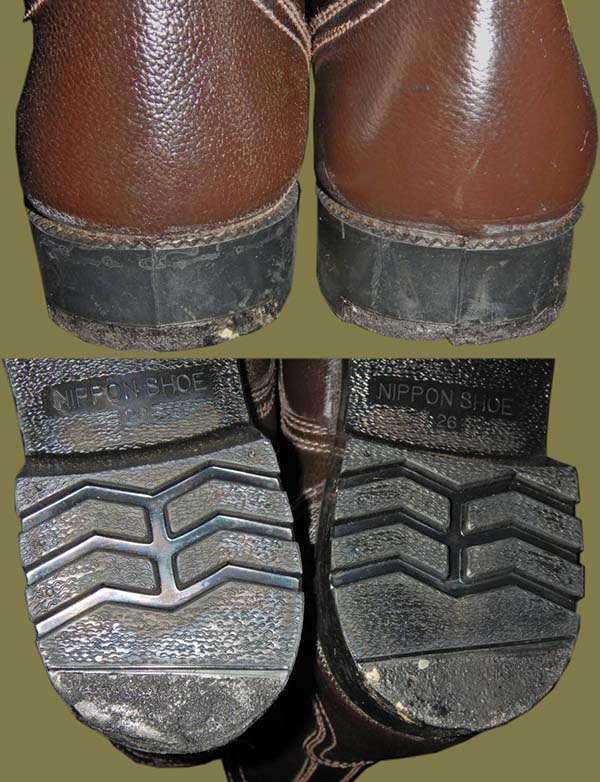
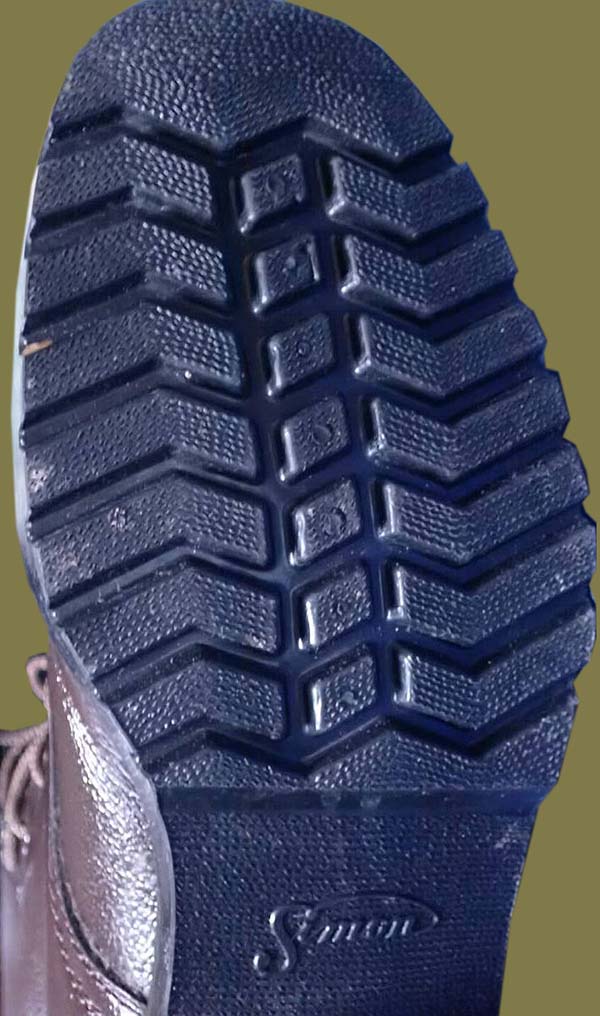
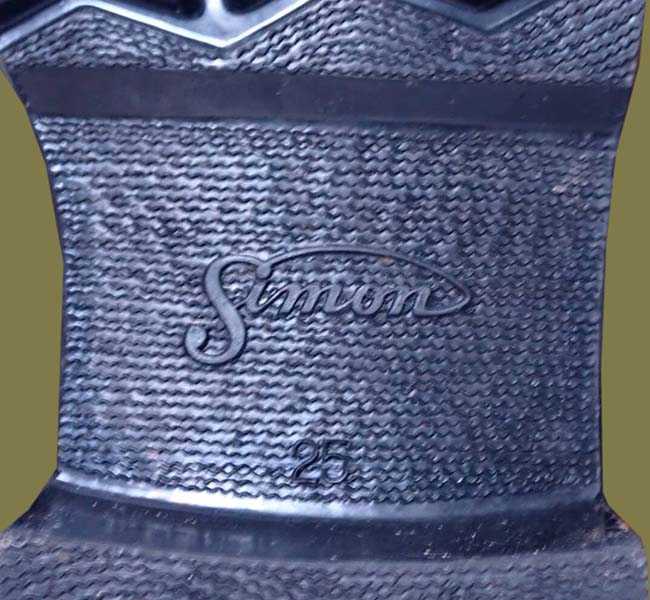
Sources of images and data:
https://en.wikipedia.org/wiki/Japan_Self-Defense_Forces
https://commons.wikimedia.org/wiki/File:Combat_boots_type_2_(Japan_Ground_Self-Defense_Force).jpg
https://ja.wikipedia.org/wiki/
https://fareastmilsim.com/jsdf-equipment
https://www.revolvy.com/page/List-of-modern-equipment-of-the-Japan-Ground-Self%252DDefense-Force?cr=1
https://www.joint-forces.com/features/19077-jgsdf-tracked-and-wheeled-vehicles-pt-1
https://iacmc.forumotion.com/t12169-little-tip-for-how-to-recognize-between-issued-one-and-commercial-pieces
https://iacmc.forumotion.com/t11560-my-jsdf-stuff
https://bzhgfa.broadgame.shop/
https://page.auctions.yahoo.co.jp
https://jp.mercari.com
https://paypayfleamarket.yahoo.co.jp
https://www.amazon.co.jp
https://aucview.aucfan.com
Exclusively for cartalana.com
We have much more interesting information on this site.
Click MENU to check it out!
∎ cartalana.com© 2009-2025 ∎ mailto: cartalana@cartalana.com